一.watcher概念
zookeeper提供给了数据的发布/订阅功能,多个订阅者可同时监听某一特定主题对象,当该主题对象的自身状态发送变化时(例如节点内容改变、节点下的子节点列表改变等),会实时、主动通知所有订阅者。
zookeeper采用了watcher机制实现数据的发布/订阅功能,该机制在被订阅对象发送变化时会异步通知客户端,因此客户端不必再watcher注册后轮询阻塞,从而减轻了客户端压力。
watcher机制实际上与观察者模式类似,也可看作是一种观察者模式在分布式场景下的实现方式。
二.Watcher架构
1.watcher实现的3个部分
- zookeeper服务端
- zookeeper客户端
- 客户端的ZKWatchManager对象
2.实现流程
客户端首先将Watcher注册到服务端,同时将Watcher对象保存到客户端的Watch管理器中。当Zookeeper服务端监听的数据状态发送变化时,服务端会主动通知客户端,接着客户端的Watch管理器会触发相关Watcher来回调相应处理逻辑,从而完成整体的数据发布/订阅流程。
3.图解

三.watcher特性
| 特性 | 说明 |
|---|---|
| 一次性 | watcher是一次性的,一旦被触发就会移除,再次使用时需要重新注册。 |
| 客户端顺序回调 | watcher回调是顺序串行化执行的,只有回调后客户端才能看到最新的数据状态。一个watcher回调逻辑不应该太多,以免影响别的watcher执行。 |
| 轻量级 | WatcherEvent是最小的通信单元,结构上质保函通知状态、事件类型和节点路径,并不会告诉数据节点变化前后的具体内容。 |
| 时效性 | watcher只有在当前session彻底失效时才会无效,若在session有效期内快速重连成功,则watcher依然存在,仍可接受到通知。 |
四.watcher的状态
1.watcher通知状态(keeperState)
keeperState是客户端与服务端连接状态发送变化时对应的通知类型。路径为org.apache.zookeeper.Watcher.Event.KeeperState,是一个枚举类,其枚举属性如下:
| 枚举属性 | 说明 |
|---|---|
| SyncConnected | 客户端与服务器正常连接时 |
| Disconnected | 客户端与服务器断开连接时 |
| Expired | 会话session失效时 |
| AuthFailed | 身份认证失败时 |
2.watcher事件类型(EventType)
EventType是数据节点(znode)发送变化时对应的通知类型。EventType变化时KeeperState永远处于SyncConnected通知状态下;当KeeperState发送变化时,EventType永远为None,其路径为org.apache.zookeeper.Watcher.Event.EventType,是一个枚举类,枚举属性如下:
| 枚举属性 | 说明 |
|---|---|
| None | 无 |
| NodeCreated | Watcher监听的数据节点被创建时 |
| NodeDeleted | Watcher监听的数据节点被删除时 |
| NodeDataChanged | Watcher监听的数据节点内容发送变更时(无论内容数据是否变化) |
| NodeChildrenChanged | Watcher监听的数据节点的子节点列表发送变更时 |
注:客户端接收到的相关事件通知中只包含状态及类型等信息,不包括节点变化前后的具体内容,变化前的数据需业务自身存储,变化后的数据需调用get等方法重新获取。
五.捕获事件的入门案例
1.说明
zookeeper的watcher监听,在zookeeper中采用zk.getChildren(path,watch)、zj.exists(path,watch)、zk.getData(path,wattcher,stat)这样的方式为某个znode注册监听。
| 注册方式 | created | childrenChanged | changed | deleted |
|---|---|---|---|---|
| zk.exists("/node-x",watcher) | 可监控 | 可监控 | 可监控 | |
| zk.getData("/node-x",watcher) | 可监控 | 可监控 | ||
| zk.getChildren("/node-x",watcher) | 可监控 | 可监控 |
2.watcher的使用范例
2.1对象说明
KeeperState:通知状态。
SyncConnected:客户端与服务器正常连接时。
Disconnected:客户端与服务器断开连接时。
Expired:会话session失效时。
AuthFailed:身份认证失败时。
事件类型为:None
2.2调用类
(2.2.1)代码块
package com.fengmo.zookeeper;
import org.apache.zookeeper.WatchedEvent;
import org.apache.zookeeper.Watcher;
import org.apache.zookeeper.ZooKeeper;
import sun.awt.windows.ThemeReader;
import java.util.concurrent.CountDownLatch;
//通过java设置监听器
public class WatcherDemo01 implements Watcher {
//计数器对象
static CountDownLatch countDownLatch = new CountDownLatch(1);
//连接对象
static ZooKeeper zooKeeper;
@Override
public void process(WatchedEvent event) {
try{
//事件类型
if(event.getType() == Event.EventType.None){
//判断连接成功
if(event.getState() == Event.KeeperState.SyncConnected){
System.out.println("连接创建watcher成功");
//唤醒主线程
countDownLatch.countDown();
}else if(event.getState() == Event.KeeperState.Disconnected){
System.out.println("断开连接");
}else if(event.getState() == Event.KeeperState.Expired){
System.out.println("会话超时");
//参数一:zookeeper服务器地址,参数二:连接超时,参数三:watcher实现类
zooKeeper = new ZooKeeper("192.168.83.136:2181",5000,new WatcherDemo01());
}else if(event.getState() == Event.KeeperState.AuthFailed){ //当scheme设置错误才通过
System.out.println("认证失败");
}
}
}catch (Exception e){
e.printStackTrace();
}
}
public static void main(String[] args) {
try {
//参数一:zookeeper服务器地址,参数二:连接超时,参数三:watcher实现类
zooKeeper = new ZooKeeper("192.168.83.136:2181",5000,new WatcherDemo01());
//阻塞线程,等待连接的创建
countDownLatch.await();
//获取会话id
System.out.println("这是会话的id" + zooKeeper.getSessionId());
//添加授权用户
zooKeeper.addAuthInfo("digest","user2:user2".getBytes());
//读取节点的数据
byte[] bytes = zooKeeper.getData("/watcher1", false, null);
System.out.println(new String(bytes));
Thread.sleep(5000);
// zooKeeper.close();
System.out.println("结束");
}catch (Exception e){
e.printStackTrace();
}
}
}
(2.2.2)范例
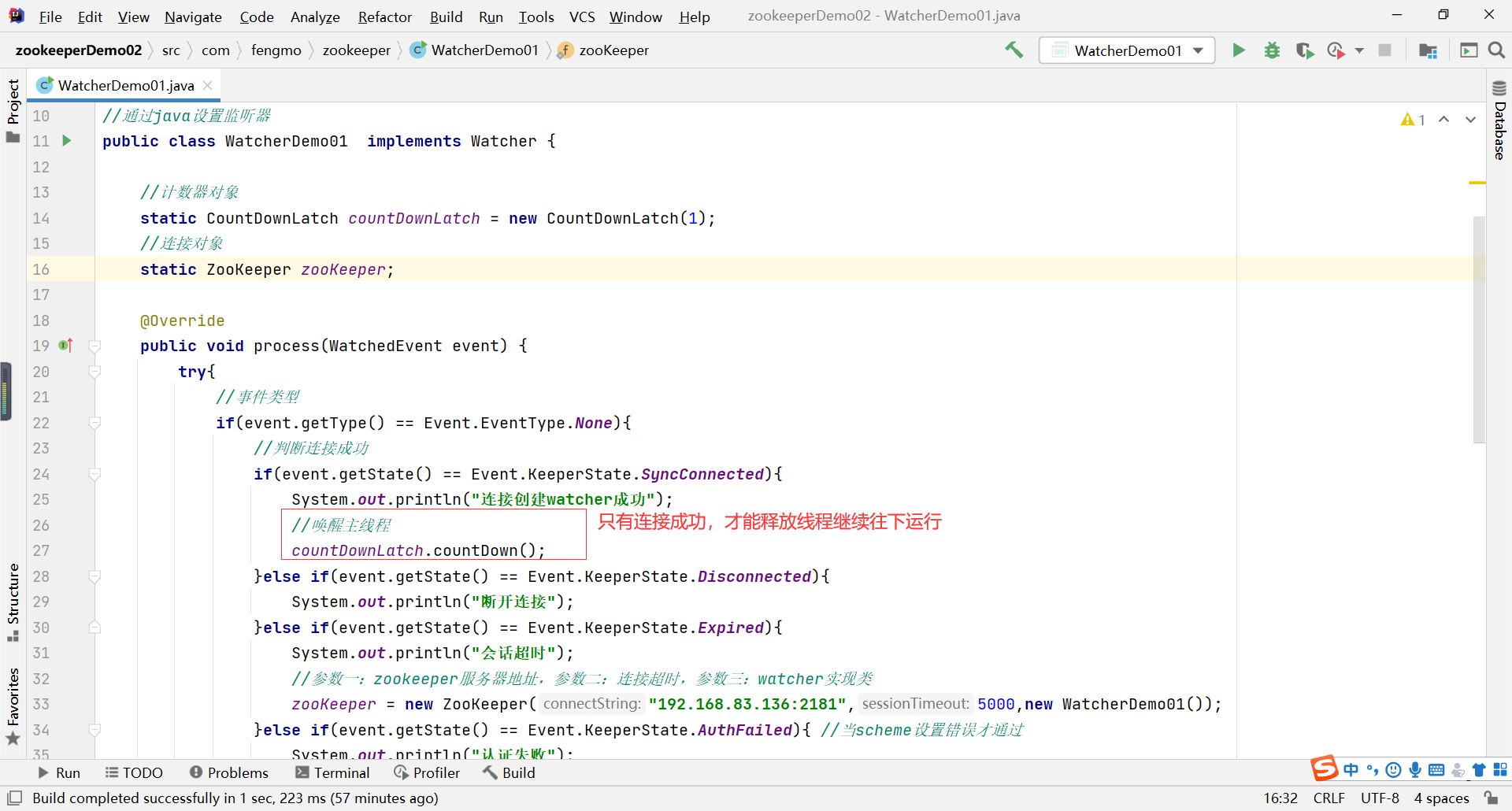
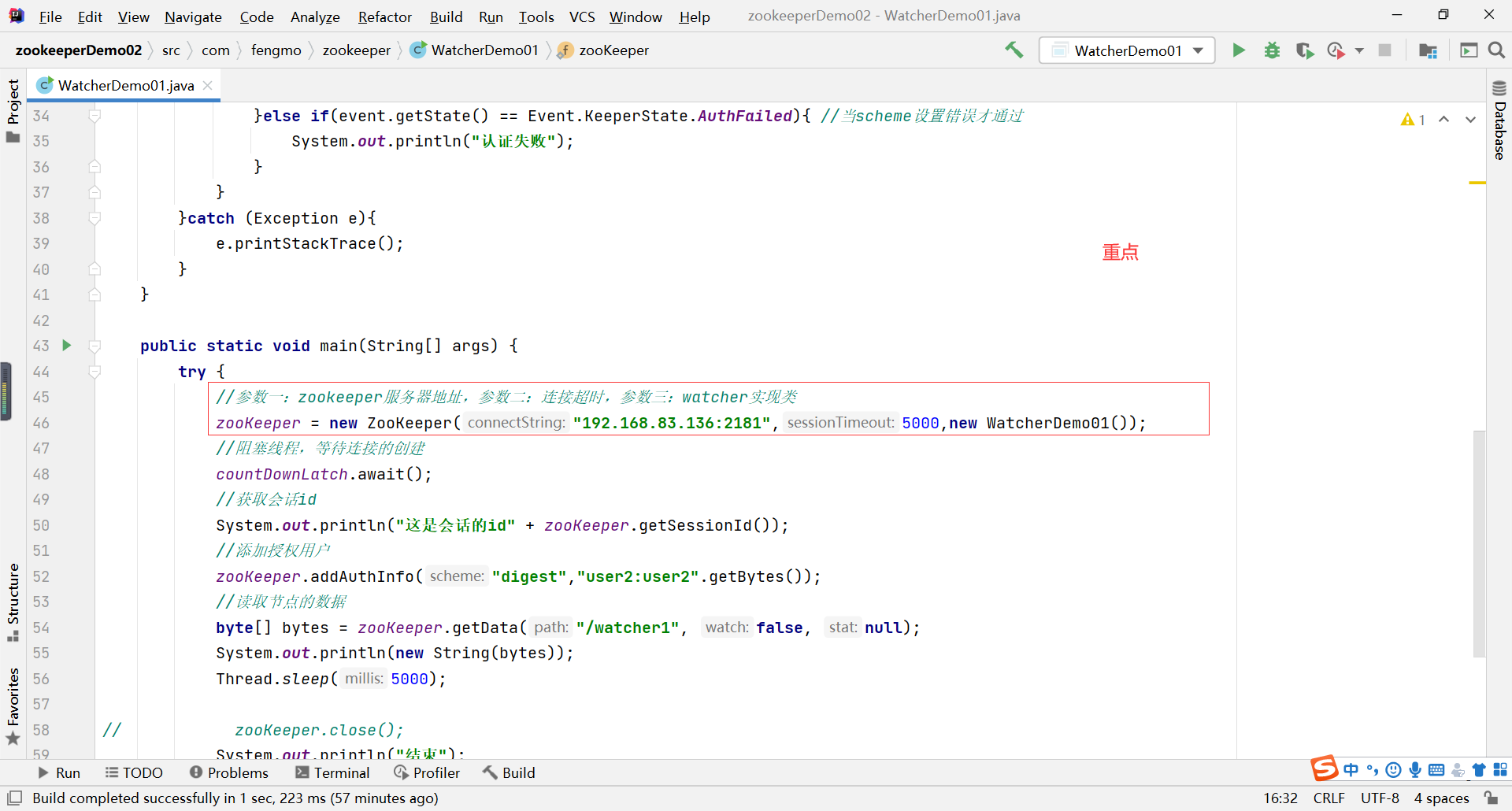
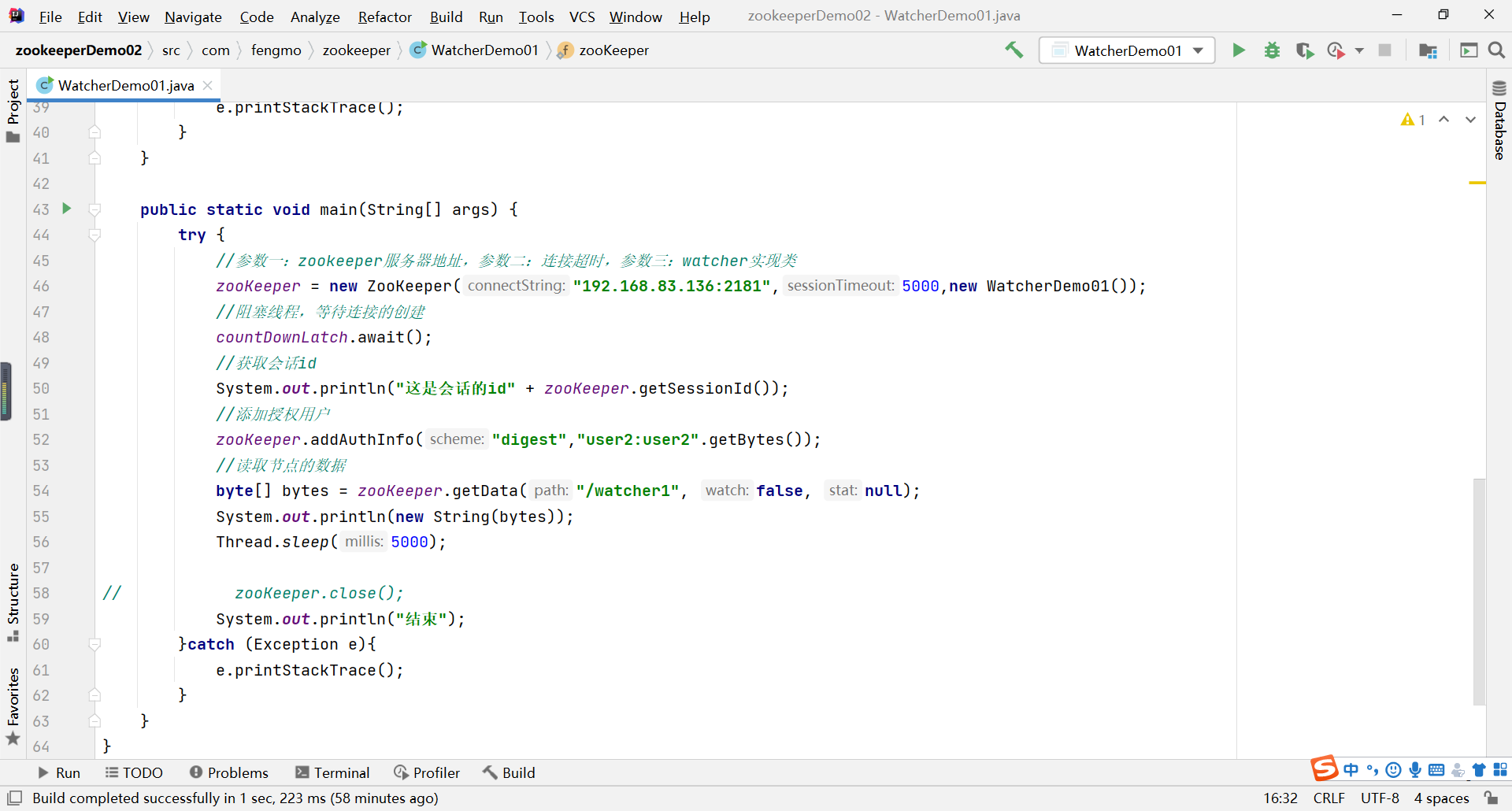
六.检查节点是否存在
1.语法
//使用连接对象的监视器
exists(String path,boolean b)
//自定义监视器
exists(String path,watcher w)
//NodeCreated:节点创建
//NodeDeleted:节点删除
//NodeDataChanged:节点内容发送变化
- path-znode路径。
- b-是否使用连接对象中注册的监视器。
- w-监视器对象。
2.演示一【创建zookeeper对象并设置监听器】
(1)代码块
package com.fengmo.zookeeper;
import org.apache.zookeeper.KeeperException;
import org.apache.zookeeper.WatchedEvent;
import org.apache.zookeeper.Watcher;
import org.apache.zookeeper.ZooKeeper;
import org.junit.After;
import org.junit.Before;
import org.junit.Test;
import java.io.IOException;
import java.util.concurrent.CountDownLatch;
//监听器的应用
public class WatcherDemo02 {
String IP = "192.168.83.136:2181";
ZooKeeper zooKeeper = null;
@Before
public void before()throws IOException,InterruptedException{
CountDownLatch countDownLatch = new CountDownLatch(1);
//连接zookeeper客户端
zooKeeper = new ZooKeeper(IP, 6000, new Watcher() {
@Override
public void process(WatchedEvent event) {
System.out.println("连接对象的参数");
//连接成功
if(event.getState() == Event.KeeperState.SyncConnected){
countDownLatch.countDown();
}
System.out.println("path=" + event.getPath());
System.out.println("eventType=" + event.getType());
}
});
countDownLatch.await();
}
@After
public void after()throws InterruptedException{
zooKeeper.close();
}
@Test
//调用创建zookeeper的时候,建立的通用监听器实现类
public void watcherExists1() throws InterruptedException, KeeperException {
//参数一:节点路径,参数二:开启监听器
zooKeeper.exists("/watcher1",true);
Thread.sleep(5000);
System.out.println("结束");
}
@Test
//调用自定义的监听器
public void watcherExists2() throws InterruptedException, KeeperException {
//参数一:节点路径,参数二:自定义监听器
zooKeeper.exists("/watcher1", new Watcher() {
@Override
public void process(WatchedEvent watchedEvent) {
System.out.println("自定义watcher");
System.out.println("path=" + watchedEvent.getPath());
System.out.println("eventType=" + watchedEvent.getType());
}
});
Thread.sleep(50000);
System.out.println("结束");
}
@Test
//调用一次性监听器
public void watcherExists3() throws InterruptedException, KeeperException {
Watcher watcher = new Watcher() {
@Override
public void process(WatchedEvent watchedEvent) {
System.out.println("自定义watcher");
System.out.println("path=" + watchedEvent.getPath());
System.out.println("eventType=" + watchedEvent.getType());
}
};
//调用一次性监听器
zooKeeper.exists("/watcher1",watcher);
Thread.sleep(500000);
System.out.println("结束");
}
@Test
//调用监听器【多次事件捕获】
public void watcherExists4() throws InterruptedException, KeeperException {
Watcher watcher = new Watcher() {
@Override
public void process(WatchedEvent watchedEvent) {
try {
System.out.println("自定义watcher");
System.out.println("path=" + watchedEvent.getPath());
System.out.println("eventType=" + watchedEvent.getType());
//调用一次性监听器
zooKeeper.exists("/watcher1", this);
}catch (Exception ex){
ex.printStackTrace();
}
}
};
Thread.sleep(500000);
System.out.println("结束");
}
@Test
//同时调用多个监听器
public void watcherExists5() throws InterruptedException, KeeperException {
//监听器1
zooKeeper.exists("/watcher1", new Watcher() {
@Override
public void process(WatchedEvent watchedEvent) {
System.out.println("1");
System.out.println("path=" + watchedEvent.getPath());
System.out.println("eventType=" + watchedEvent.getType());
}
});
//监听器二
zooKeeper.exists("/watcher1", new Watcher() {
@Override
public void process(WatchedEvent watchedEvent) {
System.out.println("2");
System.out.println("path=" + watchedEvent.getPath());
System.out.println("eventType=" + watchedEvent.getType());
}
});
Thread.sleep(500000);
System.out.println("结束");
}
}
(2)范例
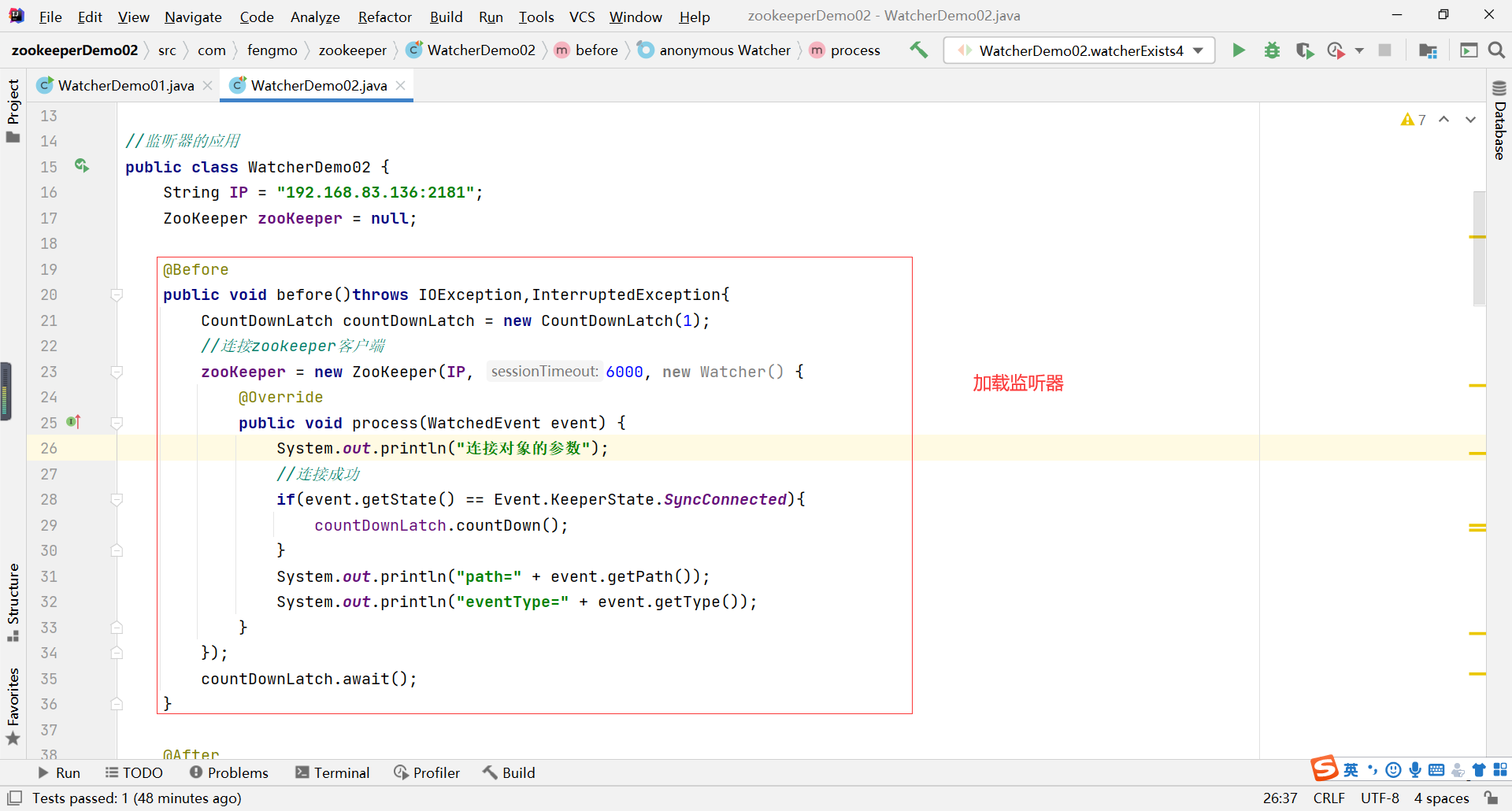

3.演示二【创建自定义监听器】
(1)代码块
package com.fengmo.zookeeper;
import org.apache.zookeeper.KeeperException;
import org.apache.zookeeper.WatchedEvent;
import org.apache.zookeeper.Watcher;
import org.apache.zookeeper.ZooKeeper;
import org.junit.After;
import org.junit.Before;
import org.junit.Test;
import java.io.IOException;
import java.util.concurrent.CountDownLatch;
//监听器的应用
public class WatcherDemo02 {
String IP = "192.168.83.136:2181";
ZooKeeper zooKeeper = null;
@Before
public void before()throws IOException,InterruptedException{
CountDownLatch countDownLatch = new CountDownLatch(1);
//连接zookeeper客户端
zooKeeper = new ZooKeeper(IP, 6000, new Watcher() {
@Override
public void process(WatchedEvent event) {
System.out.println("连接对象的参数");
//连接成功
if(event.getState() == Event.KeeperState.SyncConnected){
countDownLatch.countDown();
}
System.out.println("path=" + event.getPath());
System.out.println("eventType=" + event.getType());
}
});
countDownLatch.await();
}
@After
public void after()throws InterruptedException{
zooKeeper.close();
}
@Test
//调用创建zookeeper的时候,建立的通用监听器实现类
public void watcherExists1() throws InterruptedException, KeeperException {
//参数一:节点路径,参数二:开启监听器
zooKeeper.exists("/watcher1",true);
Thread.sleep(5000);
System.out.println("结束");
}
@Test
//调用自定义的监听器
public void watcherExists2() throws InterruptedException, KeeperException {
//参数一:节点路径,参数二:自定义监听器
zooKeeper.exists("/watcher1", new Watcher() {
@Override
public void process(WatchedEvent watchedEvent) {
System.out.println("自定义watcher");
System.out.println("path=" + watchedEvent.getPath());
System.out.println("eventType=" + watchedEvent.getType());
}
});
Thread.sleep(50000);
System.out.println("结束");
}
@Test
//调用一次性监听器
public void watcherExists3() throws InterruptedException, KeeperException {
Watcher watcher = new Watcher() {
@Override
public void process(WatchedEvent watchedEvent) {
System.out.println("自定义watcher");
System.out.println("path=" + watchedEvent.getPath());
System.out.println("eventType=" + watchedEvent.getType());
}
};
//调用一次性监听器
zooKeeper.exists("/watcher1",watcher);
Thread.sleep(500000);
System.out.println("结束");
}
@Test
//调用监听器【多次事件捕获】
public void watcherExists4() throws InterruptedException, KeeperException {
Watcher watcher = new Watcher() {
@Override
public void process(WatchedEvent watchedEvent) {
try {
System.out.println("自定义watcher");
System.out.println("path=" + watchedEvent.getPath());
System.out.println("eventType=" + watchedEvent.getType());
//调用一次性监听器
zooKeeper.exists("/watcher1", this);
}catch (Exception ex){
ex.printStackTrace();
}
}
};
Thread.sleep(500000);
System.out.println("结束");
}
@Test
//同时调用多个监听器
public void watcherExists5() throws InterruptedException, KeeperException {
//监听器1
zooKeeper.exists("/watcher1", new Watcher() {
@Override
public void process(WatchedEvent watchedEvent) {
System.out.println("1");
System.out.println("path=" + watchedEvent.getPath());
System.out.println("eventType=" + watchedEvent.getType());
}
});
//监听器二
zooKeeper.exists("/watcher1", new Watcher() {
@Override
public void process(WatchedEvent watchedEvent) {
System.out.println("2");
System.out.println("path=" + watchedEvent.getPath());
System.out.println("eventType=" + watchedEvent.getType());
}
});
Thread.sleep(500000);
System.out.println("结束");
}
}
(2)范例

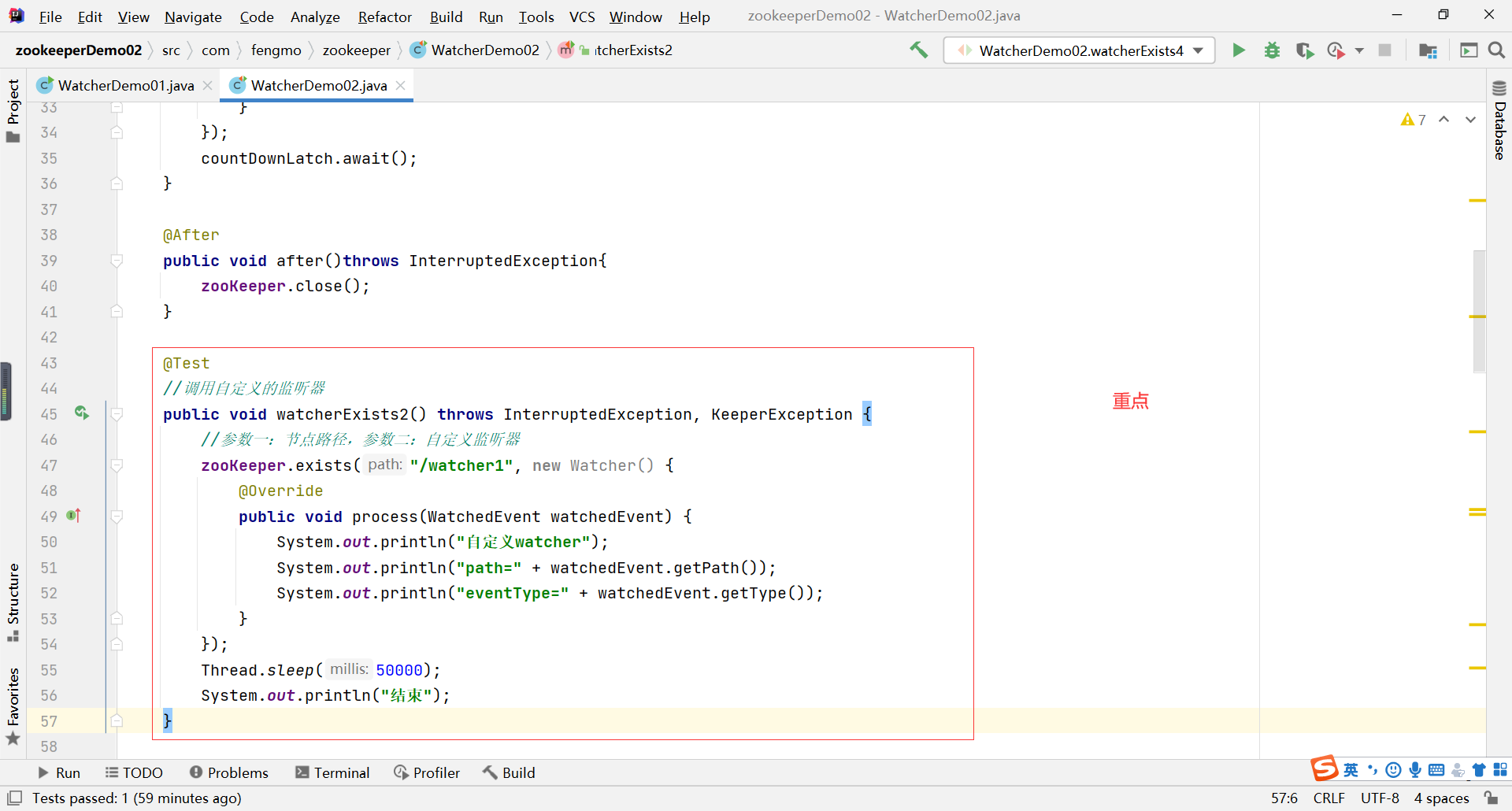
4.演示三【创建一次性监听器】
(1)代码块
package com.fengmo.zookeeper;
import org.apache.zookeeper.KeeperException;
import org.apache.zookeeper.WatchedEvent;
import org.apache.zookeeper.Watcher;
import org.apache.zookeeper.ZooKeeper;
import org.junit.After;
import org.junit.Before;
import org.junit.Test;
import java.io.IOException;
import java.util.concurrent.CountDownLatch;
//监听器的应用
public class WatcherDemo02 {
String IP = "192.168.83.136:2181";
ZooKeeper zooKeeper = null;
@Before
public void before()throws IOException,InterruptedException{
CountDownLatch countDownLatch = new CountDownLatch(1);
//连接zookeeper客户端
zooKeeper = new ZooKeeper(IP, 6000, new Watcher() {
@Override
public void process(WatchedEvent event) {
System.out.println("连接对象的参数");
//连接成功
if(event.getState() == Event.KeeperState.SyncConnected){
countDownLatch.countDown();
}
System.out.println("path=" + event.getPath());
System.out.println("eventType=" + event.getType());
}
});
countDownLatch.await();
}
@After
public void after()throws InterruptedException{
zooKeeper.close();
}
@Test
//调用一次性监听器
public void watcherExists3() throws InterruptedException, KeeperException {
Watcher watcher = new Watcher() {
@Override
public void process(WatchedEvent watchedEvent) {
System.out.println("自定义watcher");
System.out.println("path=" + watchedEvent.getPath());
System.out.println("eventType=" + watchedEvent.getType());
}
};
//调用一次性监听器
zooKeeper.exists("/watcher1",watcher);
Thread.sleep(500000);
System.out.println("结束");
}
@Test
//调用自定义的监听器
public void watcherExists2() throws InterruptedException, KeeperException {
//参数一:节点路径,参数二:自定义监听器
zooKeeper.exists("/watcher1", new Watcher() {
@Override
public void process(WatchedEvent watchedEvent) {
System.out.println("自定义watcher");
System.out.println("path=" + watchedEvent.getPath());
System.out.println("eventType=" + watchedEvent.getType());
}
});
Thread.sleep(50000);
System.out.println("结束");
}
@Test
//调用创建zookeeper的时候,建立的通用监听器实现类
public void watcherExists1() throws InterruptedException, KeeperException {
//参数一:节点路径,参数二:开启监听器
zooKeeper.exists("/watcher1",true);
Thread.sleep(5000);
System.out.println("结束");
}
@Test
//调用监听器【多次事件捕获】
public void watcherExists4() throws InterruptedException, KeeperException {
Watcher watcher = new Watcher() {
@Override
public void process(WatchedEvent watchedEvent) {
try {
System.out.println("自定义watcher");
System.out.println("path=" + watchedEvent.getPath());
System.out.println("eventType=" + watchedEvent.getType());
//调用一次性监听器
zooKeeper.exists("/watcher1", this);
}catch (Exception ex){
ex.printStackTrace();
}
}
};
Thread.sleep(500000);
System.out.println("结束");
}
@Test
//同时调用多个监听器
public void watcherExists5() throws InterruptedException, KeeperException {
//监听器1
zooKeeper.exists("/watcher1", new Watcher() {
@Override
public void process(WatchedEvent watchedEvent) {
System.out.println("1");
System.out.println("path=" + watchedEvent.getPath());
System.out.println("eventType=" + watchedEvent.getType());
}
});
//监听器二
zooKeeper.exists("/watcher1", new Watcher() {
@Override
public void process(WatchedEvent watchedEvent) {
System.out.println("2");
System.out.println("path=" + watchedEvent.getPath());
System.out.println("eventType=" + watchedEvent.getType());
}
});
Thread.sleep(500000);
System.out.println("结束");
}
}
(2)范例

5.演示四【创建持久性监听器】
(1)代码块
package com.fengmo.zookeeper;
import org.apache.zookeeper.KeeperException;
import org.apache.zookeeper.WatchedEvent;
import org.apache.zookeeper.Watcher;
import org.apache.zookeeper.ZooKeeper;
import org.junit.After;
import org.junit.Before;
import org.junit.Test;
import java.io.IOException;
import java.util.concurrent.CountDownLatch;
//监听器的应用
public class WatcherDemo02 {
String IP = "192.168.83.136:2181";
ZooKeeper zooKeeper = null;
@Before
public void before()throws IOException,InterruptedException{
CountDownLatch countDownLatch = new CountDownLatch(1);
//连接zookeeper客户端
zooKeeper = new ZooKeeper(IP, 6000, new Watcher() {
@Override
public void process(WatchedEvent event) {
System.out.println("连接对象的参数");
//连接成功
if(event.getState() == Event.KeeperState.SyncConnected){
countDownLatch.countDown();
}
System.out.println("path=" + event.getPath());
System.out.println("eventType=" + event.getType());
}
});
countDownLatch.await();
}
@After
public void after()throws InterruptedException{
zooKeeper.close();
}
@Test
//同时调用多个监听器
public void watcherExists5() throws InterruptedException, KeeperException {
//监听器1
zooKeeper.exists("/watcher1", new Watcher() {
@Override
public void process(WatchedEvent watchedEvent) {
System.out.println("1");
System.out.println("path=" + watchedEvent.getPath());
System.out.println("eventType=" + watchedEvent.getType());
}
});
//监听器二
zooKeeper.exists("/watcher1", new Watcher() {
@Override
public void process(WatchedEvent watchedEvent) {
System.out.println("2");
System.out.println("path=" + watchedEvent.getPath());
System.out.println("eventType=" + watchedEvent.getType());
}
});
Thread.sleep(500000);
System.out.println("结束");
}
@Test
//调用监听器【多次事件捕获】
public void watcherExists4() throws InterruptedException, KeeperException {
Watcher watcher = new Watcher() {
@Override
public void process(WatchedEvent watchedEvent) {
try {
System.out.println("自定义watcher");
System.out.println("path=" + watchedEvent.getPath());
System.out.println("eventType=" + watchedEvent.getType());
//调用该持久性监听器
zooKeeper.exists("/watcher1", this);
}catch (Exception ex){
ex.printStackTrace();
}
}
};
zooKeeper.exists("/watcher1", watcher);
Thread.sleep(500000);
System.out.println("结束");
}
@Test
//调用一次性监听器
public void watcherExists3() throws InterruptedException, KeeperException {
Watcher watcher = new Watcher() {
@Override
public void process(WatchedEvent watchedEvent) {
System.out.println("自定义watcher");
System.out.println("path=" + watchedEvent.getPath());
System.out.println("eventType=" + watchedEvent.getType());
}
};
//调用一次性监听器
zooKeeper.exists("/watcher1",watcher);
Thread.sleep(500000);
System.out.println("结束");
}
@Test
//调用自定义的监听器
public void watcherExists2() throws InterruptedException, KeeperException {
//参数一:节点路径,参数二:自定义监听器
zooKeeper.exists("/watcher1", new Watcher() {
@Override
public void process(WatchedEvent watchedEvent) {
System.out.println("自定义watcher");
System.out.println("path=" + watchedEvent.getPath());
System.out.println("eventType=" + watchedEvent.getType());
}
});
Thread.sleep(50000);
System.out.println("结束");
}
@Test
//调用创建zookeeper的时候,建立的通用监听器实现类
public void watcherExists1() throws InterruptedException, KeeperException {
//参数一:节点路径,参数二:开启监听器
zooKeeper.exists("/watcher1",true);
Thread.sleep(5000);
System.out.println("结束");
}
}
(2)范例
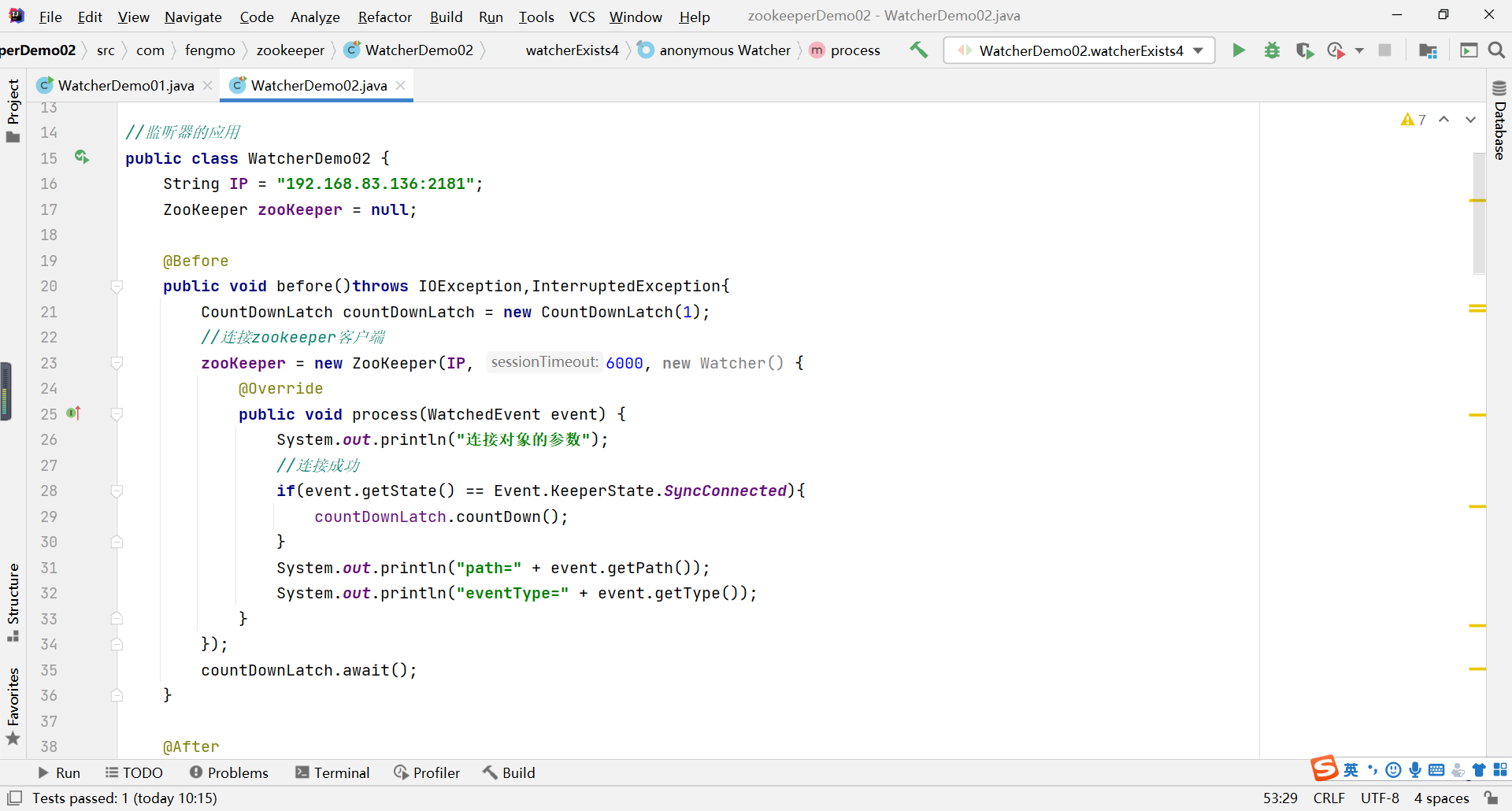
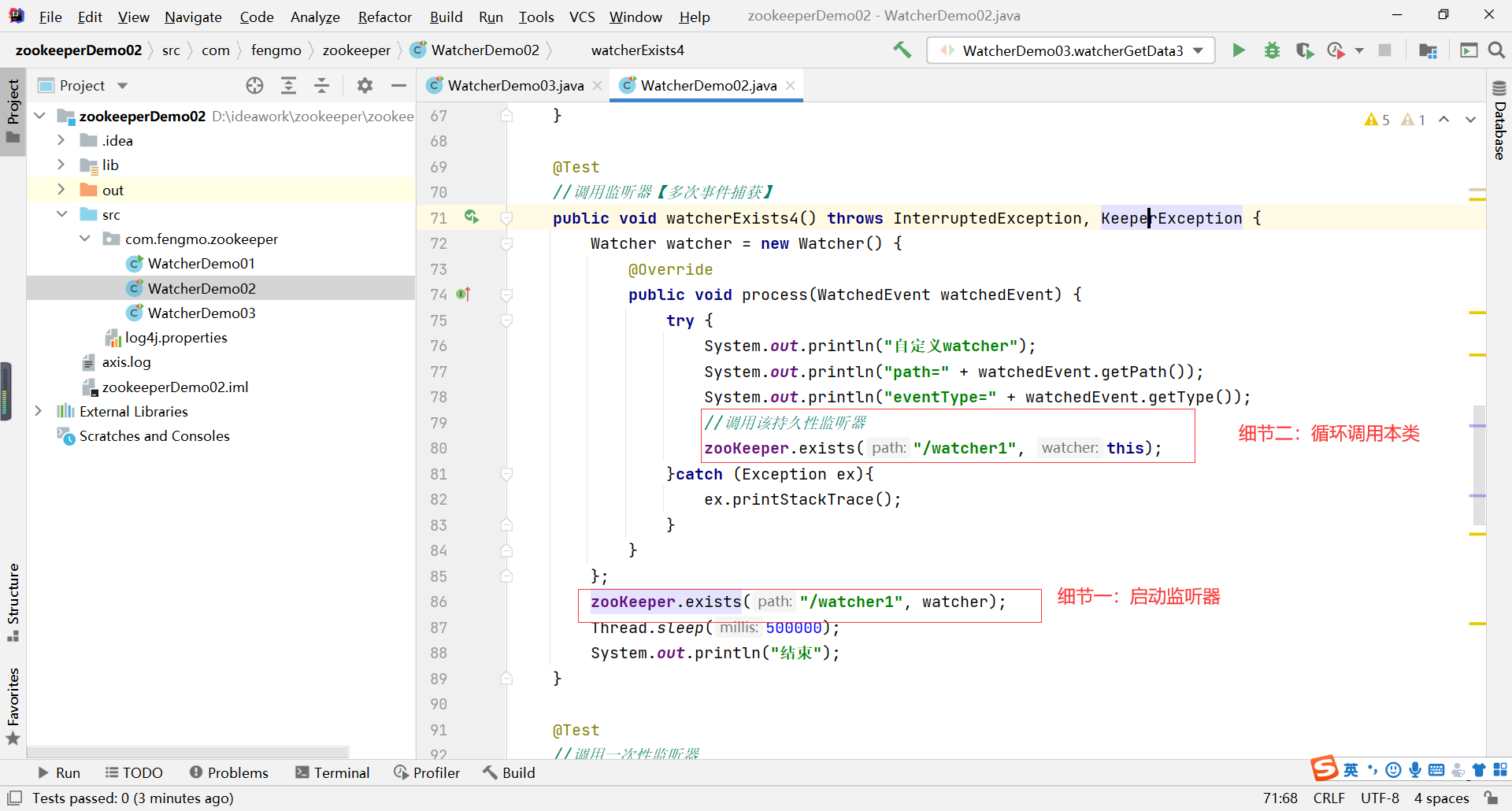
6.演示五【同时调用多个事件监听器】
(1)代码块
package com.fengmo.zookeeper;
import org.apache.zookeeper.KeeperException;
import org.apache.zookeeper.WatchedEvent;
import org.apache.zookeeper.Watcher;
import org.apache.zookeeper.ZooKeeper;
import org.junit.After;
import org.junit.Before;
import org.junit.Test;
import java.io.IOException;
import java.util.concurrent.CountDownLatch;
//监听器的应用
public class WatcherDemo02 {
String IP = "192.168.83.136:2181";
ZooKeeper zooKeeper = null;
@Before
public void before()throws IOException,InterruptedException{
CountDownLatch countDownLatch = new CountDownLatch(1);
//连接zookeeper客户端
zooKeeper = new ZooKeeper(IP, 6000, new Watcher() {
@Override
public void process(WatchedEvent event) {
System.out.println("连接对象的参数");
//连接成功
if(event.getState() == Event.KeeperState.SyncConnected){
countDownLatch.countDown();
}
System.out.println("path=" + event.getPath());
System.out.println("eventType=" + event.getType());
}
});
countDownLatch.await();
}
@After
public void after()throws InterruptedException{
zooKeeper.close();
}
@Test
//同时调用多个监听器
public void watcherExists5() throws InterruptedException, KeeperException {
//监听器1
zooKeeper.exists("/watcher1", new Watcher() {
@Override
public void process(WatchedEvent watchedEvent) {
System.out.println("1");
System.out.println("path=" + watchedEvent.getPath());
System.out.println("eventType=" + watchedEvent.getType());
}
});
//监听器二
zooKeeper.exists("/watcher1", new Watcher() {
@Override
public void process(WatchedEvent watchedEvent) {
System.out.println("2");
System.out.println("path=" + watchedEvent.getPath());
System.out.println("eventType=" + watchedEvent.getType());
}
});
Thread.sleep(500000);
System.out.println("结束");
}
@Test
//调用监听器【多次事件捕获】
public void watcherExists4() throws InterruptedException, KeeperException {
Watcher watcher = new Watcher() {
@Override
public void process(WatchedEvent watchedEvent) {
try {
System.out.println("自定义watcher");
System.out.println("path=" + watchedEvent.getPath());
System.out.println("eventType=" + watchedEvent.getType());
//调用该持久性监听器
zooKeeper.exists("/watcher1", this);
}catch (Exception ex){
ex.printStackTrace();
}
}
};
Thread.sleep(500000);
System.out.println("结束");
}
@Test
//调用一次性监听器
public void watcherExists3() throws InterruptedException, KeeperException {
Watcher watcher = new Watcher() {
@Override
public void process(WatchedEvent watchedEvent) {
System.out.println("自定义watcher");
System.out.println("path=" + watchedEvent.getPath());
System.out.println("eventType=" + watchedEvent.getType());
}
};
//调用一次性监听器
zooKeeper.exists("/watcher1",watcher);
Thread.sleep(500000);
System.out.println("结束");
}
@Test
//调用自定义的监听器
public void watcherExists2() throws InterruptedException, KeeperException {
//参数一:节点路径,参数二:自定义监听器
zooKeeper.exists("/watcher1", new Watcher() {
@Override
public void process(WatchedEvent watchedEvent) {
System.out.println("自定义watcher");
System.out.println("path=" + watchedEvent.getPath());
System.out.println("eventType=" + watchedEvent.getType());
}
});
Thread.sleep(50000);
System.out.println("结束");
}
@Test
//调用创建zookeeper的时候,建立的通用监听器实现类
public void watcherExists1() throws InterruptedException, KeeperException {
//参数一:节点路径,参数二:开启监听器
zooKeeper.exists("/watcher1",true);
Thread.sleep(5000);
System.out.println("结束");
}
}
(2)范例

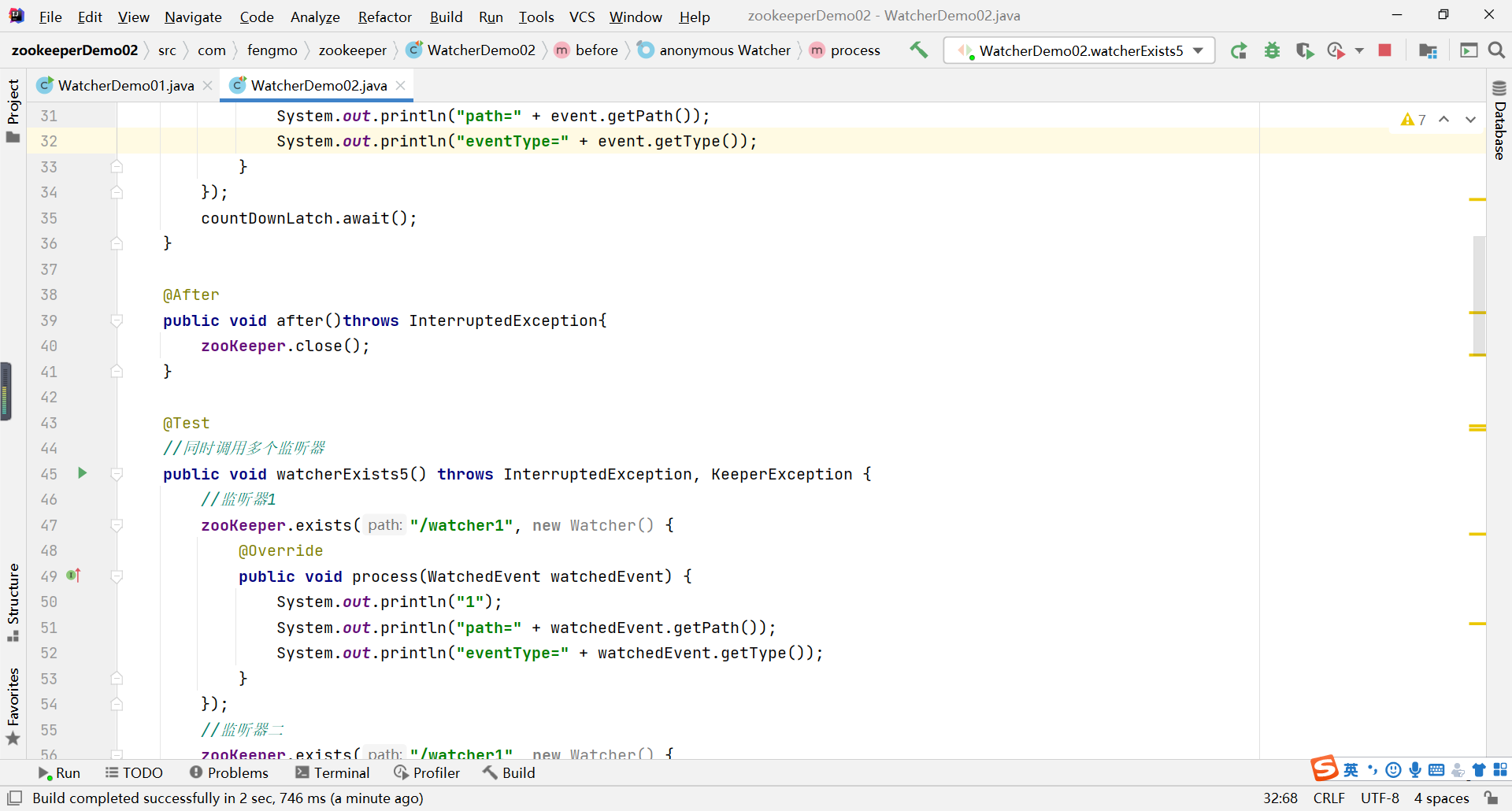

7.注意事项
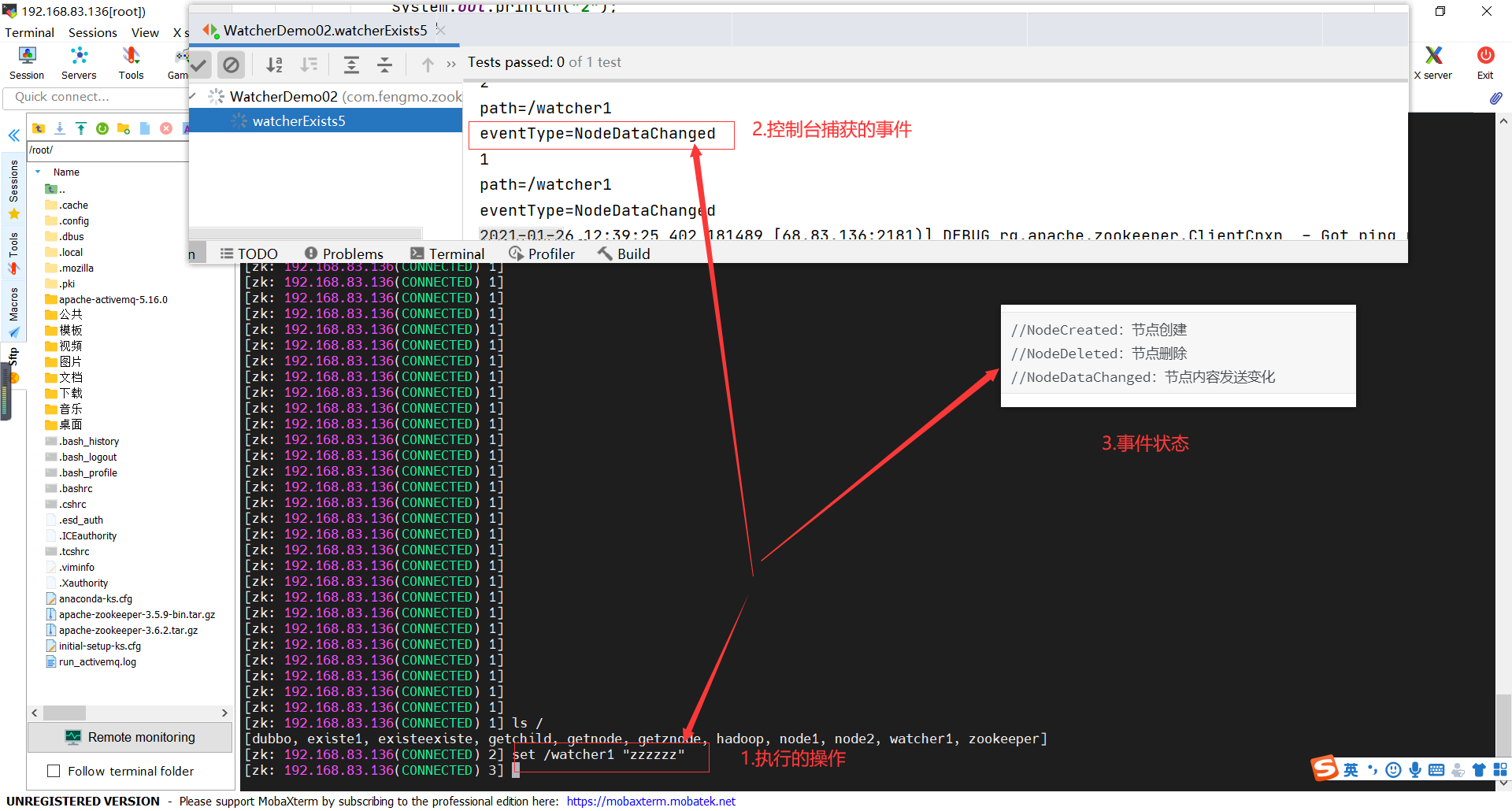
在执行测试方法的时候,在客户端进行zookeeper服务器上指定节点的增删改查功能,则控制台会返回如图显示。eventType=事件类型。
七.查看节点的信息
1.语法
//使用连接对象的监视器
getData(String path,boolean b,Stat stat)
//自定义监视器
getData(String path,watcher w,Stat stat)
//NodeDeleted:节点删除
//NodeDataChanged:节点内容发生变化
- path-znode路径。
- b-是否使用连接对象中注册的监视器。
- w-监视器对象。
- stat-返回znode的元数据。
2.演示一【通过连接对象的监听器进行监听】
(1)代码块
package com.fengmo.zookeeper;
import org.apache.zookeeper.KeeperException;
import org.apache.zookeeper.WatchedEvent;
import org.apache.zookeeper.Watcher;
import org.apache.zookeeper.ZooKeeper;
import org.junit.After;
import org.junit.Before;
import org.junit.Test;
import java.io.IOException;
import java.util.concurrent.CountDownLatch;
//监听器的应用
public class WatcherDemo03 {
String IP = "192.168.83.136:2181";
ZooKeeper zooKeeper = null;
@Before
public void before()throws IOException,InterruptedException{
CountDownLatch countDownLatch = new CountDownLatch(1);
//连接zookeeper客户端
zooKeeper = new ZooKeeper(IP, 6000, new Watcher() {
@Override
public void process(WatchedEvent event) {
System.out.println("连接对象的参数");
//连接成功
if(event.getState() == Event.KeeperState.SyncConnected){
countDownLatch.countDown();
}
System.out.println("path=" + event.getPath());
System.out.println("eventType=" + event.getType());
}
});
countDownLatch.await();
}
@After
public void after()throws InterruptedException{
zooKeeper.close();
}
@Test
//使用连接对象的监听器
public void watcherGetData1() throws InterruptedException, KeeperException {
//参数一:节点路径。参数二:连接对象的监听器开启
zooKeeper.getData("/watcher2",true,null);
Thread.sleep(50000);
System.out.println("结束");
}
@Test
//通过自定义监听器获取节点的状态信息
public void watcherGetData2() throws InterruptedException, KeeperException {
//参数一:节点路径。参数二:自定义watcher
zooKeeper.getData("/watcher2", new Watcher() {
@Override
public void process(WatchedEvent watchedEvent) {
System.out.println("捕获监听的事件");
System.out.println("path=" + watchedEvent.getPath());
System.out.println("eventType=" + watchedEvent.getType());
}
},null);
}
@Test
//调用一次性监听器
public void watcherGetData3() throws InterruptedException, KeeperException {
Watcher watcher = new Watcher() {
@Override
public void process(WatchedEvent watchedEvent) {
System.out.println("自定义watcher");
System.out.println("path=" + watchedEvent.getPath());
System.out.println("eventType=" + watchedEvent.getType());
}
};
zooKeeper.getData("/watcher2",watcher,null);
Thread.sleep(50000);
System.out.println("结束");
}
@Test
//设置持久化的监听器
public void watcherGetData4() throws InterruptedException, KeeperException {
//参数一:节点路径,参数二:自定义监听器
Watcher watcher = new Watcher() {
@Override
public void process(WatchedEvent watchedEvent) {
try {
System.out.println("自定义watcher");
System.out.println("path=" + watchedEvent.getPath());
System.out.println("eventType=" + watchedEvent.getType());
//判断通过则循环调用本类
if(watchedEvent.getType() == Event.EventType.NodeDataChanged) {
zooKeeper.getData("/watcher2", this, null);
}
}catch (Exception e){
e.printStackTrace();
}
}
};
zooKeeper.getData("/watcher2", watcher, null);
Thread.sleep(50000);
System.out.println("结束");
}
@Test
//同时注册多个监听器
public void watcherGetData5() throws InterruptedException, KeeperException {
zooKeeper.getData("/watcher2", new Watcher() {
@Override
public void process(WatchedEvent watchedEvent) {
System.out.println("开启第一个监听器");
System.out.println("path=" + watchedEvent.getPath());
System.out.println("eventType=" + watchedEvent.getType());
}
},null);
zooKeeper.getData("/watcher2", new Watcher() {
@Override
public void process(WatchedEvent watchedEvent) {
System.out.println("开启第二个监听器");
System.out.println("path=" + watchedEvent.getPath());
System.out.println("eventType=" + watchedEvent.getType());
}
},null);
Thread.sleep(50000);
System.out.println("结束");
}
}
(2)范例
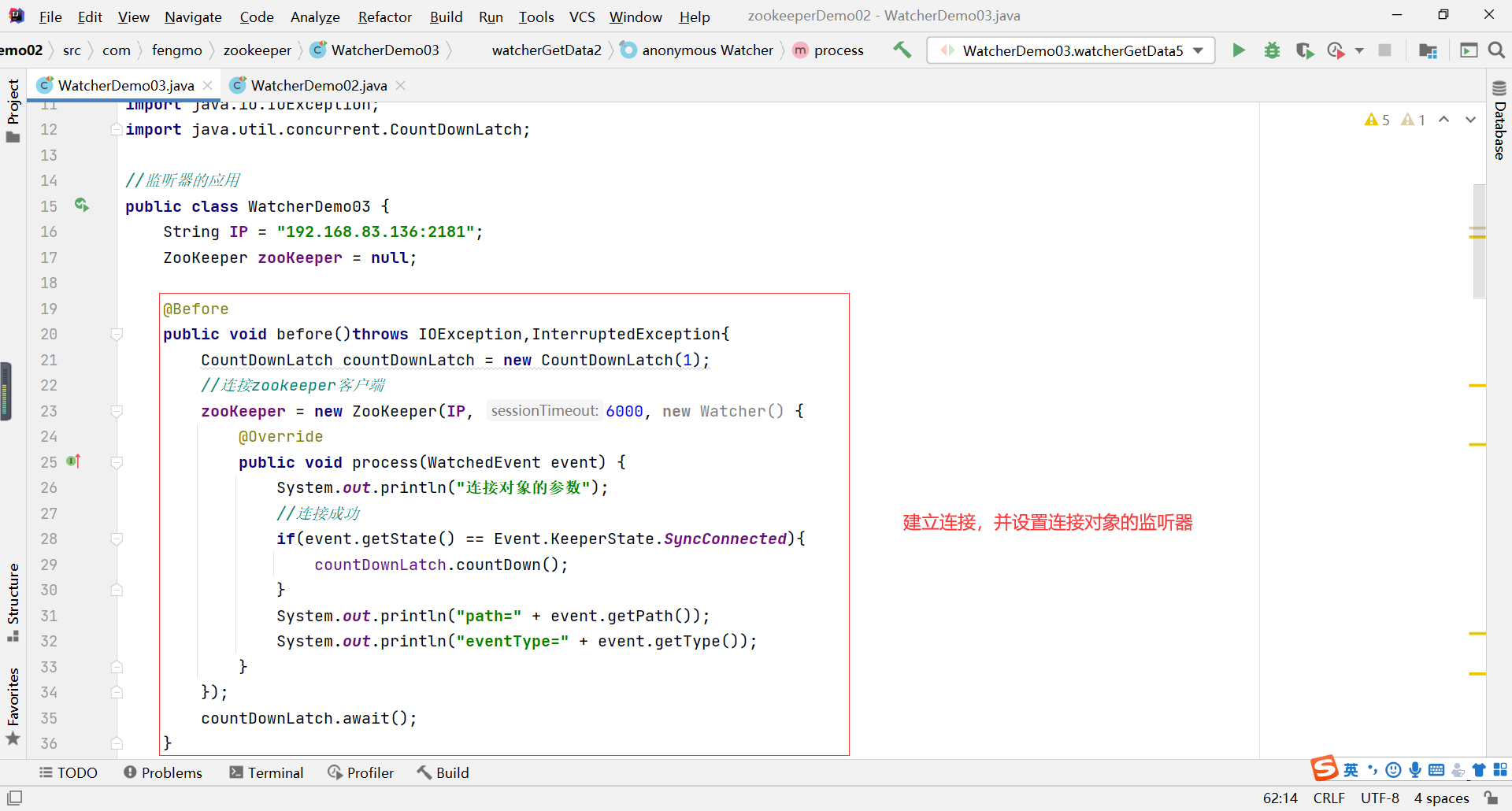

3.演示二【通过自定义监听器来获取节点状态】
(1)代码块
package com.fengmo.zookeeper;
import org.apache.zookeeper.KeeperException;
import org.apache.zookeeper.WatchedEvent;
import org.apache.zookeeper.Watcher;
import org.apache.zookeeper.ZooKeeper;
import org.junit.After;
import org.junit.Before;
import org.junit.Test;
import java.io.IOException;
import java.util.concurrent.CountDownLatch;
//监听器的应用
public class WatcherDemo03 {
String IP = "192.168.83.136:2181";
ZooKeeper zooKeeper = null;
@Before
public void before()throws IOException,InterruptedException{
CountDownLatch countDownLatch = new CountDownLatch(1);
//连接zookeeper客户端
zooKeeper = new ZooKeeper(IP, 6000, new Watcher() {
@Override
public void process(WatchedEvent event) {
System.out.println("连接对象的参数");
//连接成功
if(event.getState() == Event.KeeperState.SyncConnected){
countDownLatch.countDown();
}
System.out.println("path=" + event.getPath());
System.out.println("eventType=" + event.getType());
}
});
countDownLatch.await();
}
@After
public void after()throws InterruptedException{
zooKeeper.close();
}
@Test
//使用连接对象的监听器
public void watcherGetData1() throws InterruptedException, KeeperException {
//参数一:节点路径。参数二:连接对象的监听器开启
zooKeeper.getData("/watcher2",true,null);
Thread.sleep(50000);
System.out.println("结束");
}
@Test
//通过自定义监听器获取节点的状态信息
public void watcherGetData2() throws InterruptedException, KeeperException {
//参数一:节点路径。参数二:自定义watcher
zooKeeper.getData("/watcher2", new Watcher() {
@Override
public void process(WatchedEvent watchedEvent) {
System.out.println("捕获监听的事件");
System.out.println("path=" + watchedEvent.getPath());
System.out.println("eventType=" + watchedEvent.getType());
}
},null);
}
@Test
//调用一次性监听器
public void watcherGetData3() throws InterruptedException, KeeperException {
Watcher watcher = new Watcher() {
@Override
public void process(WatchedEvent watchedEvent) {
System.out.println("自定义watcher");
System.out.println("path=" + watchedEvent.getPath());
System.out.println("eventType=" + watchedEvent.getType());
}
};
zooKeeper.getData("/watcher2",watcher,null);
Thread.sleep(50000);
System.out.println("结束");
}
@Test
//设置持久化的监听器
public void watcherGetData4() throws InterruptedException, KeeperException {
//参数一:节点路径,参数二:自定义监听器
Watcher watcher = new Watcher() {
@Override
public void process(WatchedEvent watchedEvent) {
try {
System.out.println("自定义watcher");
System.out.println("path=" + watchedEvent.getPath());
System.out.println("eventType=" + watchedEvent.getType());
//判断通过则循环调用本类
if(watchedEvent.getType() == Event.EventType.NodeDataChanged) {
zooKeeper.getData("/watcher2", this, null);
}
}catch (Exception e){
e.printStackTrace();
}
}
};
zooKeeper.getData("/watcher2", watcher, null);
Thread.sleep(50000);
System.out.println("结束");
}
@Test
//同时注册多个监听器
public void watcherGetData5() throws InterruptedException, KeeperException {
zooKeeper.getData("/watcher2", new Watcher() {
@Override
public void process(WatchedEvent watchedEvent) {
System.out.println("开启第一个监听器");
System.out.println("path=" + watchedEvent.getPath());
System.out.println("eventType=" + watchedEvent.getType());
}
},null);
zooKeeper.getData("/watcher2", new Watcher() {
@Override
public void process(WatchedEvent watchedEvent) {
System.out.println("开启第二个监听器");
System.out.println("path=" + watchedEvent.getPath());
System.out.println("eventType=" + watchedEvent.getType());
}
},null);
Thread.sleep(50000);
System.out.println("结束");
}
}
(2)范例

4.演示三【调用一次性监听器】
(1)代码块
package com.fengmo.zookeeper;
import org.apache.zookeeper.KeeperException;
import org.apache.zookeeper.WatchedEvent;
import org.apache.zookeeper.Watcher;
import org.apache.zookeeper.ZooKeeper;
import org.junit.After;
import org.junit.Before;
import org.junit.Test;
import java.io.IOException;
import java.util.concurrent.CountDownLatch;
//监听器的应用
public class WatcherDemo03 {
String IP = "192.168.83.136:2181";
ZooKeeper zooKeeper = null;
@Before
public void before()throws IOException,InterruptedException{
CountDownLatch countDownLatch = new CountDownLatch(1);
//连接zookeeper客户端
zooKeeper = new ZooKeeper(IP, 6000, new Watcher() {
@Override
public void process(WatchedEvent event) {
System.out.println("连接对象的参数");
//连接成功
if(event.getState() == Event.KeeperState.SyncConnected){
countDownLatch.countDown();
}
System.out.println("path=" + event.getPath());
System.out.println("eventType=" + event.getType());
}
});
countDownLatch.await();
}
@After
public void after()throws InterruptedException{
zooKeeper.close();
}
@Test
//使用连接对象的监听器
public void watcherGetData1() throws InterruptedException, KeeperException {
//参数一:节点路径。参数二:连接对象的监听器开启
zooKeeper.getData("/watcher2",true,null);
Thread.sleep(50000);
System.out.println("结束");
}
@Test
//通过自定义监听器获取节点的状态信息
public void watcherGetData2() throws InterruptedException, KeeperException {
//参数一:节点路径。参数二:自定义watcher
zooKeeper.getData("/watcher2", new Watcher() {
@Override
public void process(WatchedEvent watchedEvent) {
System.out.println("捕获监听的事件");
System.out.println("path=" + watchedEvent.getPath());
System.out.println("eventType=" + watchedEvent.getType());
}
},null);
}
@Test
//调用一次性监听器
public void watcherGetData3() throws InterruptedException, KeeperException {
Watcher watcher = new Watcher() {
@Override
public void process(WatchedEvent watchedEvent) {
System.out.println("自定义watcher");
System.out.println("path=" + watchedEvent.getPath());
System.out.println("eventType=" + watchedEvent.getType());
}
};
zooKeeper.getData("/watcher2",watcher,null);
Thread.sleep(50000);
System.out.println("结束");
}
@Test
//设置持久化的监听器
public void watcherGetData4() throws InterruptedException, KeeperException {
//参数一:节点路径,参数二:自定义监听器
Watcher watcher = new Watcher() {
@Override
public void process(WatchedEvent watchedEvent) {
try {
System.out.println("自定义watcher");
System.out.println("path=" + watchedEvent.getPath());
System.out.println("eventType=" + watchedEvent.getType());
//判断通过则循环调用本类
if(watchedEvent.getType() == Event.EventType.NodeDataChanged) {
zooKeeper.getData("/watcher2", this, null);
}
}catch (Exception e){
e.printStackTrace();
}
}
};
zooKeeper.getData("/watcher2", watcher, null);
Thread.sleep(50000);
System.out.println("结束");
}
@Test
//同时注册多个监听器
public void watcherGetData5() throws InterruptedException, KeeperException {
zooKeeper.getData("/watcher2", new Watcher() {
@Override
public void process(WatchedEvent watchedEvent) {
System.out.println("开启第一个监听器");
System.out.println("path=" + watchedEvent.getPath());
System.out.println("eventType=" + watchedEvent.getType());
}
},null);
zooKeeper.getData("/watcher2", new Watcher() {
@Override
public void process(WatchedEvent watchedEvent) {
System.out.println("开启第二个监听器");
System.out.println("path=" + watchedEvent.getPath());
System.out.println("eventType=" + watchedEvent.getType());
}
},null);
Thread.sleep(50000);
System.out.println("结束");
}
}
(2)范例
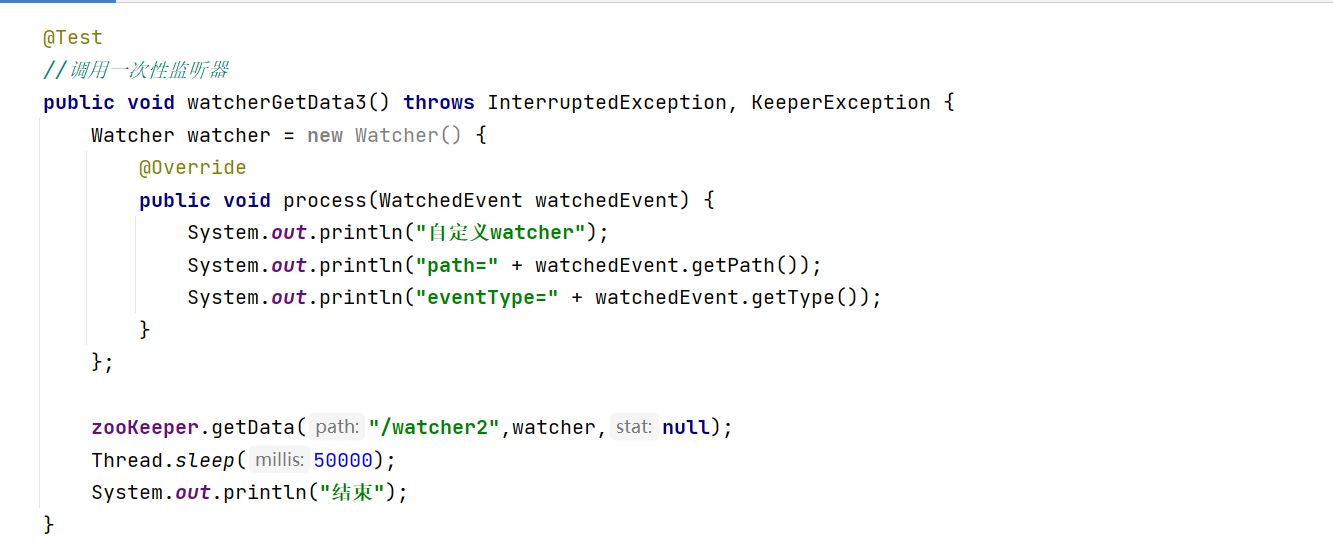
5.演示四【持久化监听器】
(1)代码块
package com.fengmo.zookeeper;
import org.apache.zookeeper.KeeperException;
import org.apache.zookeeper.WatchedEvent;
import org.apache.zookeeper.Watcher;
import org.apache.zookeeper.ZooKeeper;
import org.junit.After;
import org.junit.Before;
import org.junit.Test;
import java.io.IOException;
import java.util.concurrent.CountDownLatch;
//监听器的应用
public class WatcherDemo03 {
String IP = "192.168.83.136:2181";
ZooKeeper zooKeeper = null;
@Before
public void before()throws IOException,InterruptedException{
CountDownLatch countDownLatch = new CountDownLatch(1);
//连接zookeeper客户端
zooKeeper = new ZooKeeper(IP, 6000, new Watcher() {
@Override
public void process(WatchedEvent event) {
System.out.println("连接对象的参数");
//连接成功
if(event.getState() == Event.KeeperState.SyncConnected){
countDownLatch.countDown();
}
System.out.println("path=" + event.getPath());
System.out.println("eventType=" + event.getType());
}
});
countDownLatch.await();
}
@After
public void after()throws InterruptedException{
zooKeeper.close();
}
@Test
//使用连接对象的监听器
public void watcherGetData1() throws InterruptedException, KeeperException {
//参数一:节点路径。参数二:连接对象的监听器开启
zooKeeper.getData("/watcher2",true,null);
Thread.sleep(50000);
System.out.println("结束");
}
@Test
//通过自定义监听器获取节点的状态信息
public void watcherGetData2() throws InterruptedException, KeeperException {
//参数一:节点路径。参数二:自定义watcher
zooKeeper.getData("/watcher2", new Watcher() {
@Override
public void process(WatchedEvent watchedEvent) {
System.out.println("捕获监听的事件");
System.out.println("path=" + watchedEvent.getPath());
System.out.println("eventType=" + watchedEvent.getType());
}
},null);
}
@Test
//调用一次性监听器
public void watcherGetData3() throws InterruptedException, KeeperException {
Watcher watcher = new Watcher() {
@Override
public void process(WatchedEvent watchedEvent) {
System.out.println("自定义watcher");
System.out.println("path=" + watchedEvent.getPath());
System.out.println("eventType=" + watchedEvent.getType());
}
};
zooKeeper.getData("/watcher2",watcher,null);
Thread.sleep(50000);
System.out.println("结束");
}
@Test
//设置持久化的监听器
public void watcherGetData4() throws InterruptedException, KeeperException {
//参数一:节点路径,参数二:自定义监听器
Watcher watcher = new Watcher() {
@Override
public void process(WatchedEvent watchedEvent) {
try {
System.out.println("自定义watcher");
System.out.println("path=" + watchedEvent.getPath());
System.out.println("eventType=" + watchedEvent.getType());
//判断通过则循环调用本类
if(watchedEvent.getType() == Event.EventType.NodeDataChanged) {
zooKeeper.getData("/watcher2", this, null);
}
}catch (Exception e){
e.printStackTrace();
}
}
};
zooKeeper.getData("/watcher2", watcher, null);
Thread.sleep(50000);
System.out.println("结束");
}
@Test
//同时注册多个监听器
public void watcherGetData5() throws InterruptedException, KeeperException {
zooKeeper.getData("/watcher2", new Watcher() {
@Override
public void process(WatchedEvent watchedEvent) {
System.out.println("开启第一个监听器");
System.out.println("path=" + watchedEvent.getPath());
System.out.println("eventType=" + watchedEvent.getType());
}
},null);
zooKeeper.getData("/watcher2", new Watcher() {
@Override
public void process(WatchedEvent watchedEvent) {
System.out.println("开启第二个监听器");
System.out.println("path=" + watchedEvent.getPath());
System.out.println("eventType=" + watchedEvent.getType());
}
},null);
Thread.sleep(50000);
System.out.println("结束");
}
}
(2)范例
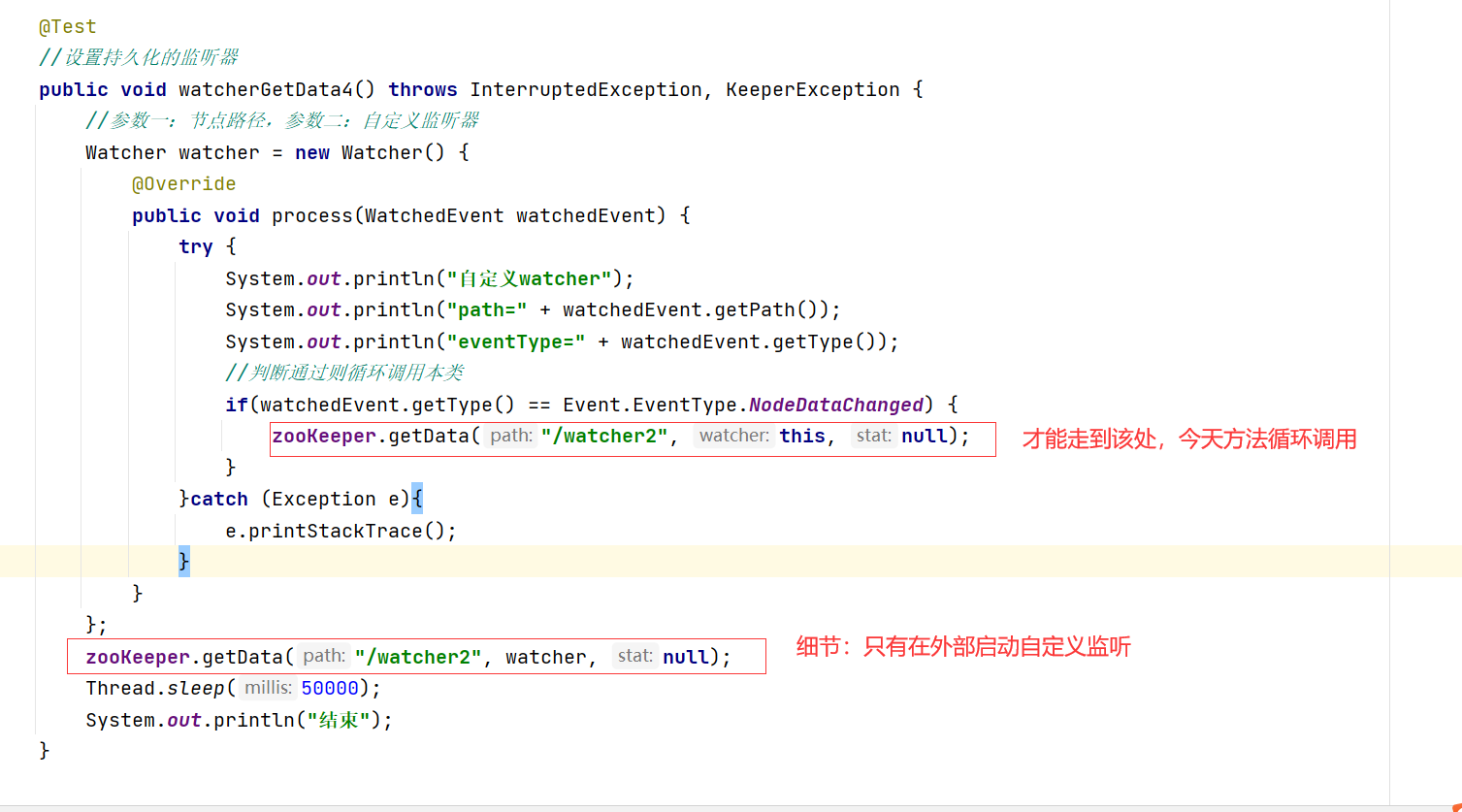
6.演示五【同时注册多个监听器】
(1)代码块
(2)范例package com.fengmo.zookeeper;
import org.apache.zookeeper.KeeperException;
import org.apache.zookeeper.WatchedEvent;
import org.apache.zookeeper.Watcher;
import org.apache.zookeeper.ZooKeeper;
import org.junit.After;
import org.junit.Before;
import org.junit.Test;
import java.io.IOException;
import java.util.concurrent.CountDownLatch;
//监听器的应用
public class WatcherDemo03 {
String IP = "192.168.83.136:2181";
ZooKeeper zooKeeper = null;
@Before
public void before()throws IOException,InterruptedException{
CountDownLatch countDownLatch = new CountDownLatch(1);
//连接zookeeper客户端
zooKeeper = new ZooKeeper(IP, 6000, new Watcher() {
@Override
public void process(WatchedEvent event) {
System.out.println("连接对象的参数");
//连接成功
if(event.getState() == Event.KeeperState.SyncConnected){
countDownLatch.countDown();
}
System.out.println("path=" + event.getPath());
System.out.println("eventType=" + event.getType());
}
});
countDownLatch.await();
}
@After
public void after()throws InterruptedException{
zooKeeper.close();
}
@Test
//使用连接对象的监听器
public void watcherGetData1() throws InterruptedException, KeeperException {
//参数一:节点路径。参数二:连接对象的监听器开启
zooKeeper.getData("/watcher2",true,null);
Thread.sleep(50000);
System.out.println("结束");
}
@Test
//通过自定义监听器获取节点的状态信息
public void watcherGetData2() throws InterruptedException, KeeperException {
//参数一:节点路径。参数二:自定义watcher
zooKeeper.getData("/watcher2", new Watcher() {
@Override
public void process(WatchedEvent watchedEvent) {
System.out.println("捕获监听的事件");
System.out.println("path=" + watchedEvent.getPath());
System.out.println("eventType=" + watchedEvent.getType());
}
},null);
}
@Test
//调用一次性监听器
public void watcherGetData3() throws InterruptedException, KeeperException {
Watcher watcher = new Watcher() {
@Override
public void process(WatchedEvent watchedEvent) {
System.out.println("自定义watcher");
System.out.println("path=" + watchedEvent.getPath());
System.out.println("eventType=" + watchedEvent.getType());
}
};
zooKeeper.getData("/watcher2",watcher,null);
Thread.sleep(50000);
System.out.println("结束");
}
@Test
//设置持久化的监听器
public void watcherGetData4() throws InterruptedException, KeeperException {
//参数一:节点路径,参数二:自定义监听器
Watcher watcher = new Watcher() {
@Override
public void process(WatchedEvent watchedEvent) {
try {
System.out.println("自定义watcher");
System.out.println("path=" + watchedEvent.getPath());
System.out.println("eventType=" + watchedEvent.getType());
//判断通过则循环调用本类
if(watchedEvent.getType() == Event.EventType.NodeDataChanged) {
zooKeeper.getData("/watcher2", this, null);
}
}catch (Exception e){
e.printStackTrace();
}
}
};
zooKeeper.getData("/watcher2", watcher, null);
Thread.sleep(50000);
System.out.println("结束");
}
@Test
//同时注册多个监听器
public void watcherGetData5() throws InterruptedException, KeeperException {
zooKeeper.getData("/watcher2", new Watcher() {
@Override
public void process(WatchedEvent watchedEvent) {
System.out.println("开启第一个监听器");
System.out.println("path=" + watchedEvent.getPath());
System.out.println("eventType=" + watchedEvent.getType());
}
},null);
zooKeeper.getData("/watcher2", new Watcher() {
@Override
public void process(WatchedEvent watchedEvent) {
System.out.println("开启第二个监听器");
System.out.println("path=" + watchedEvent.getPath());
System.out.println("eventType=" + watchedEvent.getType());
}
},null);
Thread.sleep(50000);
System.out.println("结束");
}
}
(2)范例
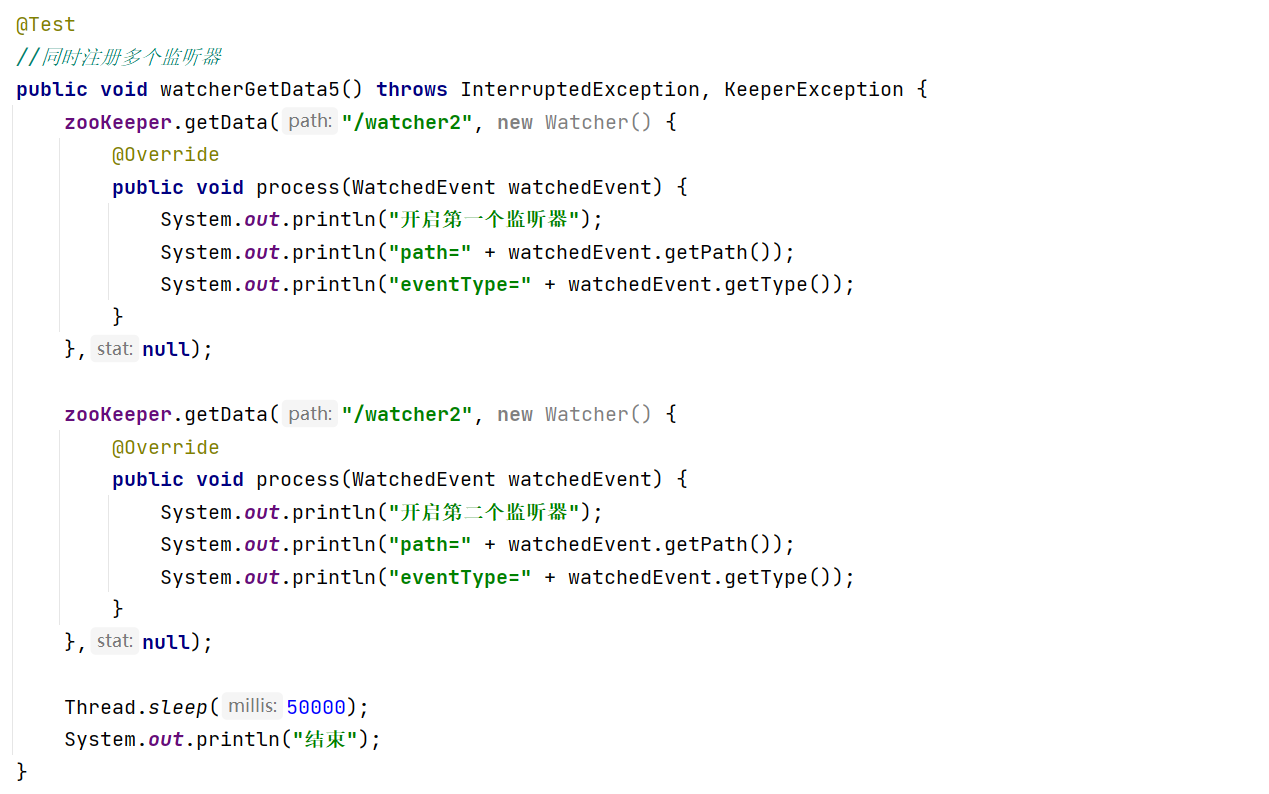
八.查看子节点
1.语法
//使用连接对象的监听器
getChildren(String path,boolean b)
//自定义监视器
getChildren(String path,Watcher w)
//NodeChildrenChanged:子节点发生变化
//b-是否使用连接对象中注册的监视器
//w-监视器对象
2.演示一【通过连接对象的监听器进行监听】
(1)代码块
package com.fengmo.zookeeper;
import org.apache.zookeeper.KeeperException;
import org.apache.zookeeper.WatchedEvent;
import org.apache.zookeeper.Watcher;
import org.apache.zookeeper.ZooKeeper;
import org.junit.After;
import org.junit.Before;
import org.junit.Test;
import java.io.IOException;
import java.util.concurrent.CountDownLatch;
//监听器的应用
public class WatcherDemo04 {
String IP = "192.168.83.136:2181";
ZooKeeper zooKeeper = null;
@Before
public void before()throws IOException,InterruptedException{
CountDownLatch countDownLatch = new CountDownLatch(1);
//连接zookeeper客户端
zooKeeper = new ZooKeeper(IP, 6000, new Watcher() {
@Override
public void process(WatchedEvent event) {
System.out.println("连接对象的参数");
//连接成功
if(event.getState() == Event.KeeperState.SyncConnected){
countDownLatch.countDown();
}
System.out.println("path=" + event.getPath());
System.out.println("eventType=" + event.getType());
}
});
countDownLatch.await();
}
@After
public void after()throws InterruptedException{
zooKeeper.close();
}
@Test
//使用连接对象的监听器
public void watcherGetChild1() throws InterruptedException, KeeperException {
//参数一:节点路径。参数二:连接对象的监听器开启
zooKeeper.getChildren("/watcher2",true);
Thread.sleep(50000);
System.out.println("结束");
}
@Test
//通过自定义监听器获取子节点
public void watcherGetChild2() throws InterruptedException, KeeperException {
//参数一:节点路径。参数二:自定义watcher
zooKeeper.getChildren("/watcher2", new Watcher() {
@Override
public void process(WatchedEvent watchedEvent) {
System.out.println("捕获监听的事件");
System.out.println("path=" + watchedEvent.getPath());
System.out.println("eventType=" + watchedEvent.getType());
}
},null);
Thread.sleep(50000);
System.out.println("结束");
}
@Test
//调用一次性监听器
public void watcherGetChild3() throws InterruptedException, KeeperException {
Watcher watcher = new Watcher() {
@Override
public void process(WatchedEvent watchedEvent) {
System.out.println("自定义watcher");
System.out.println("path=" + watchedEvent.getPath());
System.out.println("eventType=" + watchedEvent.getType());
}
};
zooKeeper.getChildren("/watcher2",watcher);
Thread.sleep(50000);
System.out.println("结束");
}
@Test
//设置持久化的监听器
public void watcherGetChild4() throws InterruptedException, KeeperException {
//参数一:节点路径,参数二:自定义监听器
Watcher watcher = new Watcher() {
@Override
public void process(WatchedEvent watchedEvent) {
try {
System.out.println("自定义watcher");
System.out.println("path=" + watchedEvent.getPath());
System.out.println("eventType=" + watchedEvent.getType());
//判断通过则循环调用本类
if(watchedEvent.getType() == Event.EventType.NodeChildrenChanged) {
zooKeeper.getChildren("/watcher2", this);
}
}catch (Exception e){
e.printStackTrace();
}
}
};
zooKeeper.getChildren("/watcher2", watcher);
Thread.sleep(50000);
System.out.println("结束");
}
@Test
//同时注册多个监听器
public void watcherGetChild5() throws InterruptedException, KeeperException {
zooKeeper.getChildren("/watcher2", new Watcher() {
@Override
public void process(WatchedEvent watchedEvent) {
System.out.println("开启第一个监听器");
System.out.println("path=" + watchedEvent.getPath());
System.out.println("eventType=" + watchedEvent.getType());
}
});
zooKeeper.getChildren("/watcher2", new Watcher() {
@Override
public void process(WatchedEvent watchedEvent) {
System.out.println("开启第二个监听器");
System.out.println("path=" + watchedEvent.getPath());
System.out.println("eventType=" + watchedEvent.getType());
}
});
Thread.sleep(50000);
System.out.println("结束");
}
}
(2)范例


3.演示二【通过自定义监听器进行监听】
(1)代码块
package com.fengmo.zookeeper;
import org.apache.zookeeper.KeeperException;
import org.apache.zookeeper.WatchedEvent;
import org.apache.zookeeper.Watcher;
import org.apache.zookeeper.ZooKeeper;
import org.junit.After;
import org.junit.Before;
import org.junit.Test;
import java.io.IOException;
import java.util.concurrent.CountDownLatch;
//监听器的应用
public class WatcherDemo04 {
String IP = "192.168.83.136:2181";
ZooKeeper zooKeeper = null;
@Before
public void before()throws IOException,InterruptedException{
CountDownLatch countDownLatch = new CountDownLatch(1);
//连接zookeeper客户端
zooKeeper = new ZooKeeper(IP, 6000, new Watcher() {
@Override
public void process(WatchedEvent event) {
System.out.println("连接对象的参数");
//连接成功
if(event.getState() == Event.KeeperState.SyncConnected){
countDownLatch.countDown();
}
System.out.println("path=" + event.getPath());
System.out.println("eventType=" + event.getType());
}
});
countDownLatch.await();
}
@After
public void after()throws InterruptedException{
zooKeeper.close();
}
@Test
//使用连接对象的监听器
public void watcherGetChild1() throws InterruptedException, KeeperException {
//参数一:节点路径。参数二:连接对象的监听器开启
zooKeeper.getChildren("/watcher2",true);
Thread.sleep(50000);
System.out.println("结束");
}
@Test
//通过自定义监听器获取子节点
public void watcherGetChild2() throws InterruptedException, KeeperException {
//参数一:节点路径。参数二:自定义watcher
zooKeeper.getChildren("/watcher2", new Watcher() {
@Override
public void process(WatchedEvent watchedEvent) {
System.out.println("捕获监听的事件");
System.out.println("path=" + watchedEvent.getPath());
System.out.println("eventType=" + watchedEvent.getType());
}
},null);
Thread.sleep(50000);
System.out.println("结束");
}
@Test
//调用一次性监听器
public void watcherGetChild3() throws InterruptedException, KeeperException {
Watcher watcher = new Watcher() {
@Override
public void process(WatchedEvent watchedEvent) {
System.out.println("自定义watcher");
System.out.println("path=" + watchedEvent.getPath());
System.out.println("eventType=" + watchedEvent.getType());
}
};
zooKeeper.getChildren("/watcher2",watcher);
Thread.sleep(50000);
System.out.println("结束");
}
@Test
//设置持久化的监听器
public void watcherGetChild4() throws InterruptedException, KeeperException {
//参数一:节点路径,参数二:自定义监听器
Watcher watcher = new Watcher() {
@Override
public void process(WatchedEvent watchedEvent) {
try {
System.out.println("自定义watcher");
System.out.println("path=" + watchedEvent.getPath());
System.out.println("eventType=" + watchedEvent.getType());
//判断通过则循环调用本类
if(watchedEvent.getType() == Event.EventType.NodeChildrenChanged) {
zooKeeper.getChildren("/watcher2", this);
}
}catch (Exception e){
e.printStackTrace();
}
}
};
zooKeeper.getChildren("/watcher2", watcher);
Thread.sleep(50000);
System.out.println("结束");
}
@Test
//同时注册多个监听器
public void watcherGetChild5() throws InterruptedException, KeeperException {
zooKeeper.getChildren("/watcher2", new Watcher() {
@Override
public void process(WatchedEvent watchedEvent) {
System.out.println("开启第一个监听器");
System.out.println("path=" + watchedEvent.getPath());
System.out.println("eventType=" + watchedEvent.getType());
}
});
zooKeeper.getChildren("/watcher2", new Watcher() {
@Override
public void process(WatchedEvent watchedEvent) {
System.out.println("开启第二个监听器");
System.out.println("path=" + watchedEvent.getPath());
System.out.println("eventType=" + watchedEvent.getType());
}
});
Thread.sleep(50000);
System.out.println("结束");
}
}
(2)范例
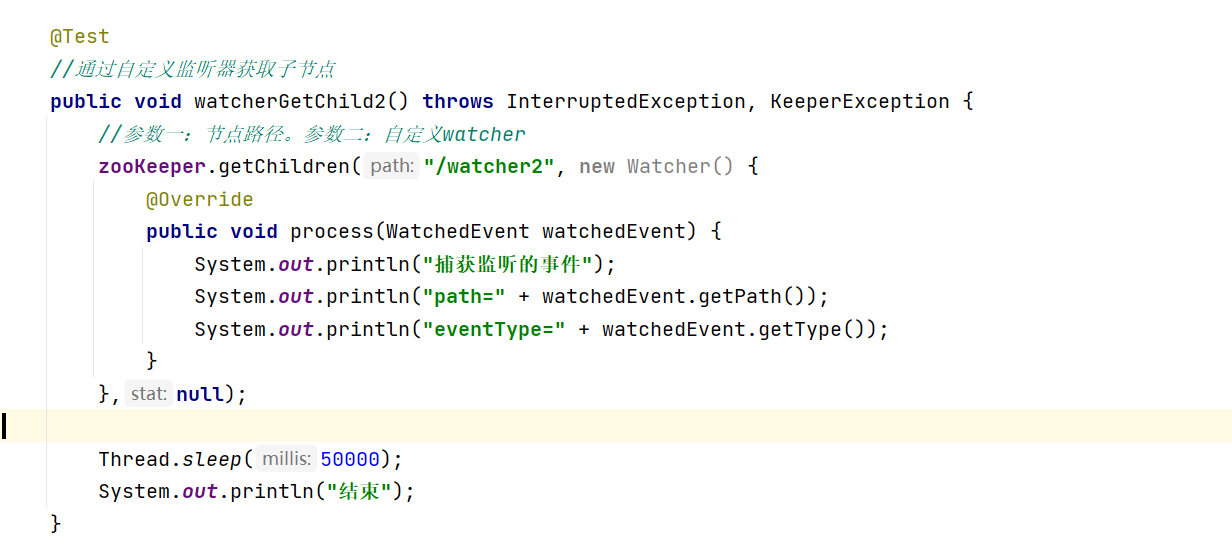
4.演示三【设置一次性监听器】
(1)代码块
package com.fengmo.zookeeper;
import org.apache.zookeeper.KeeperException;
import org.apache.zookeeper.WatchedEvent;
import org.apache.zookeeper.Watcher;
import org.apache.zookeeper.ZooKeeper;
import org.junit.After;
import org.junit.Before;
import org.junit.Test;
import java.io.IOException;
import java.util.concurrent.CountDownLatch;
//监听器的应用
public class WatcherDemo04 {
String IP = "192.168.83.136:2181";
ZooKeeper zooKeeper = null;
@Before
public void before()throws IOException,InterruptedException{
CountDownLatch countDownLatch = new CountDownLatch(1);
//连接zookeeper客户端
zooKeeper = new ZooKeeper(IP, 6000, new Watcher() {
@Override
public void process(WatchedEvent event) {
System.out.println("连接对象的参数");
//连接成功
if(event.getState() == Event.KeeperState.SyncConnected){
countDownLatch.countDown();
}
System.out.println("path=" + event.getPath());
System.out.println("eventType=" + event.getType());
}
});
countDownLatch.await();
}
@After
public void after()throws InterruptedException{
zooKeeper.close();
}
@Test
//使用连接对象的监听器
public void watcherGetChild1() throws InterruptedException, KeeperException {
//参数一:节点路径。参数二:连接对象的监听器开启
zooKeeper.getChildren("/watcher2",true);
Thread.sleep(50000);
System.out.println("结束");
}
@Test
//通过自定义监听器获取子节点
public void watcherGetChild2() throws InterruptedException, KeeperException {
//参数一:节点路径。参数二:自定义watcher
zooKeeper.getChildren("/watcher2", new Watcher() {
@Override
public void process(WatchedEvent watchedEvent) {
System.out.println("捕获监听的事件");
System.out.println("path=" + watchedEvent.getPath());
System.out.println("eventType=" + watchedEvent.getType());
}
},null);
Thread.sleep(50000);
System.out.println("结束");
}
@Test
//调用一次性监听器
public void watcherGetChild3() throws InterruptedException, KeeperException {
Watcher watcher = new Watcher() {
@Override
public void process(WatchedEvent watchedEvent) {
System.out.println("自定义watcher");
System.out.println("path=" + watchedEvent.getPath());
System.out.println("eventType=" + watchedEvent.getType());
}
};
zooKeeper.getChildren("/watcher2",watcher);
Thread.sleep(50000);
System.out.println("结束");
}
@Test
//设置持久化的监听器
public void watcherGetChild4() throws InterruptedException, KeeperException {
//参数一:节点路径,参数二:自定义监听器
Watcher watcher = new Watcher() {
@Override
public void process(WatchedEvent watchedEvent) {
try {
System.out.println("自定义watcher");
System.out.println("path=" + watchedEvent.getPath());
System.out.println("eventType=" + watchedEvent.getType());
//判断通过则循环调用本类
if(watchedEvent.getType() == Event.EventType.NodeChildrenChanged) {
zooKeeper.getChildren("/watcher2", this);
}
}catch (Exception e){
e.printStackTrace();
}
}
};
zooKeeper.getChildren("/watcher2", watcher);
Thread.sleep(50000);
System.out.println("结束");
}
@Test
//同时注册多个监听器
public void watcherGetChild5() throws InterruptedException, KeeperException {
zooKeeper.getChildren("/watcher2", new Watcher() {
@Override
public void process(WatchedEvent watchedEvent) {
System.out.println("开启第一个监听器");
System.out.println("path=" + watchedEvent.getPath());
System.out.println("eventType=" + watchedEvent.getType());
}
});
zooKeeper.getChildren("/watcher2", new Watcher() {
@Override
public void process(WatchedEvent watchedEvent) {
System.out.println("开启第二个监听器");
System.out.println("path=" + watchedEvent.getPath());
System.out.println("eventType=" + watchedEvent.getType());
}
});
Thread.sleep(50000);
System.out.println("结束");
}
}
(2)范例
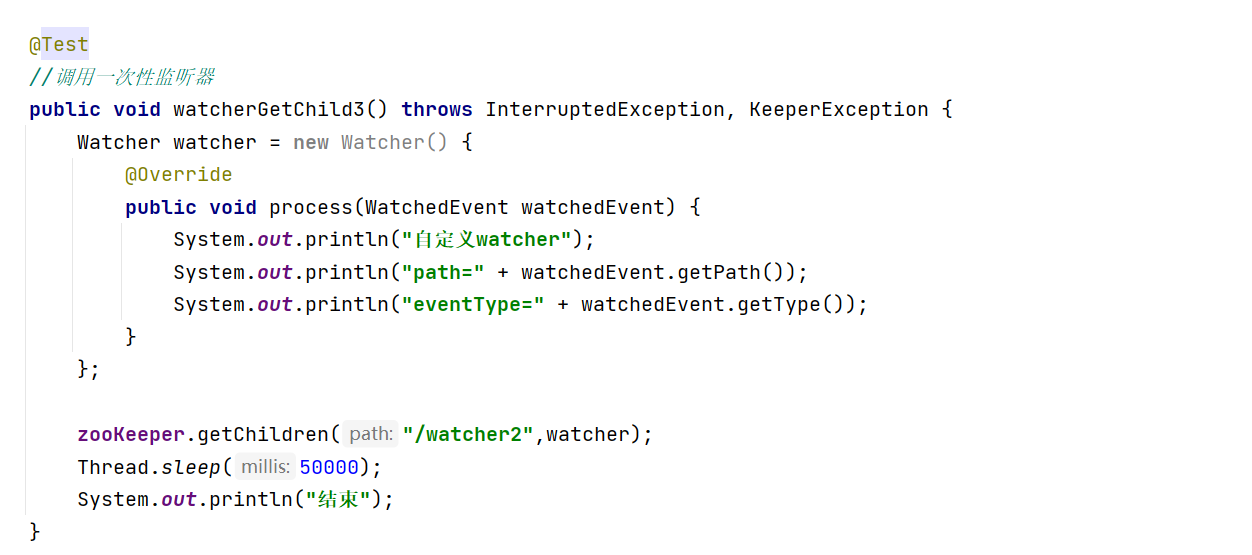
5.演示四【持久性监听器】
(1)代码块
package com.fengmo.zookeeper;
import org.apache.zookeeper.KeeperException;
import org.apache.zookeeper.WatchedEvent;
import org.apache.zookeeper.Watcher;
import org.apache.zookeeper.ZooKeeper;
import org.junit.After;
import org.junit.Before;
import org.junit.Test;
import java.io.IOException;
import java.util.concurrent.CountDownLatch;
//监听器的应用
public class WatcherDemo04 {
String IP = "192.168.83.136:2181";
ZooKeeper zooKeeper = null;
@Before
public void before()throws IOException,InterruptedException{
CountDownLatch countDownLatch = new CountDownLatch(1);
//连接zookeeper客户端
zooKeeper = new ZooKeeper(IP, 6000, new Watcher() {
@Override
public void process(WatchedEvent event) {
System.out.println("连接对象的参数");
//连接成功
if(event.getState() == Event.KeeperState.SyncConnected){
countDownLatch.countDown();
}
System.out.println("path=" + event.getPath());
System.out.println("eventType=" + event.getType());
}
});
countDownLatch.await();
}
@After
public void after()throws InterruptedException{
zooKeeper.close();
}
@Test
//使用连接对象的监听器
public void watcherGetChild1() throws InterruptedException, KeeperException {
//参数一:节点路径。参数二:连接对象的监听器开启
zooKeeper.getChildren("/watcher2",true);
Thread.sleep(50000);
System.out.println("结束");
}
@Test
//通过自定义监听器获取子节点
public void watcherGetChild2() throws InterruptedException, KeeperException {
//参数一:节点路径。参数二:自定义watcher
zooKeeper.getChildren("/watcher2", new Watcher() {
@Override
public void process(WatchedEvent watchedEvent) {
System.out.println("捕获监听的事件");
System.out.println("path=" + watchedEvent.getPath());
System.out.println("eventType=" + watchedEvent.getType());
}
},null);
Thread.sleep(50000);
System.out.println("结束");
}
@Test
//调用一次性监听器
public void watcherGetChild3() throws InterruptedException, KeeperException {
Watcher watcher = new Watcher() {
@Override
public void process(WatchedEvent watchedEvent) {
System.out.println("自定义watcher");
System.out.println("path=" + watchedEvent.getPath());
System.out.println("eventType=" + watchedEvent.getType());
}
};
zooKeeper.getChildren("/watcher2",watcher);
Thread.sleep(50000);
System.out.println("结束");
}
@Test
//设置持久化的监听器
public void watcherGetChild4() throws InterruptedException, KeeperException {
//参数一:节点路径,参数二:自定义监听器
Watcher watcher = new Watcher() {
@Override
public void process(WatchedEvent watchedEvent) {
try {
System.out.println("自定义watcher");
System.out.println("path=" + watchedEvent.getPath());
System.out.println("eventType=" + watchedEvent.getType());
//判断通过则循环调用本类
if(watchedEvent.getType() == Event.EventType.NodeChildrenChanged) {
zooKeeper.getChildren("/watcher2", this);
}
}catch (Exception e){
e.printStackTrace();
}
}
};
zooKeeper.getChildren("/watcher2", watcher);
Thread.sleep(50000);
System.out.println("结束");
}
@Test
//同时注册多个监听器
public void watcherGetChild5() throws InterruptedException, KeeperException {
zooKeeper.getChildren("/watcher2", new Watcher() {
@Override
public void process(WatchedEvent watchedEvent) {
System.out.println("开启第一个监听器");
System.out.println("path=" + watchedEvent.getPath());
System.out.println("eventType=" + watchedEvent.getType());
}
});
zooKeeper.getChildren("/watcher2", new Watcher() {
@Override
public void process(WatchedEvent watchedEvent) {
System.out.println("开启第二个监听器");
System.out.println("path=" + watchedEvent.getPath());
System.out.println("eventType=" + watchedEvent.getType());
}
});
Thread.sleep(50000);
System.out.println("结束");
}
}
(2)范例
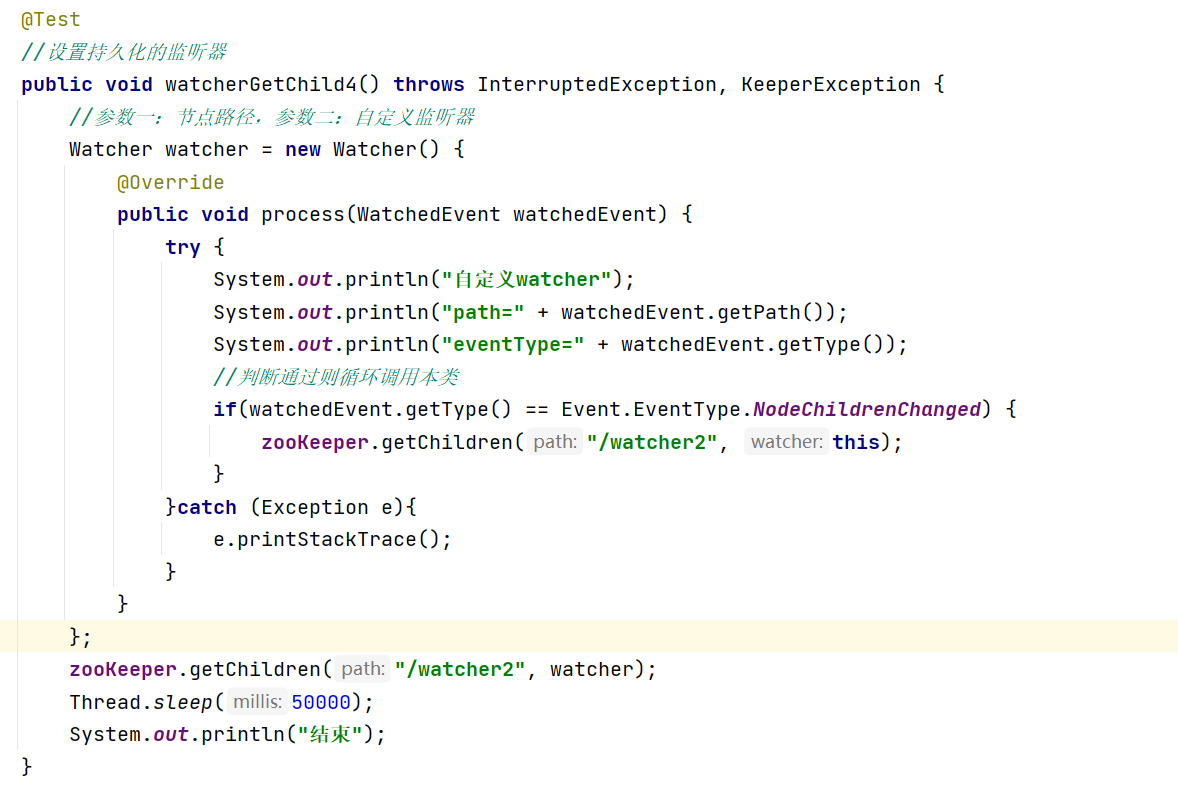
6.演示五【同时调用多个监听器】
(1)代码块
package com.fengmo.zookeeper;
import org.apache.zookeeper.KeeperException;
import org.apache.zookeeper.WatchedEvent;
import org.apache.zookeeper.Watcher;
import org.apache.zookeeper.ZooKeeper;
import org.junit.After;
import org.junit.Before;
import org.junit.Test;
import java.io.IOException;
import java.util.concurrent.CountDownLatch;
//监听器的应用
public class WatcherDemo04 {
String IP = "192.168.83.136:2181";
ZooKeeper zooKeeper = null;
@Before
public void before()throws IOException,InterruptedException{
CountDownLatch countDownLatch = new CountDownLatch(1);
//连接zookeeper客户端
zooKeeper = new ZooKeeper(IP, 6000, new Watcher() {
@Override
public void process(WatchedEvent event) {
System.out.println("连接对象的参数");
//连接成功
if(event.getState() == Event.KeeperState.SyncConnected){
countDownLatch.countDown();
}
System.out.println("path=" + event.getPath());
System.out.println("eventType=" + event.getType());
}
});
countDownLatch.await();
}
@After
public void after()throws InterruptedException{
zooKeeper.close();
}
@Test
//使用连接对象的监听器
public void watcherGetChild1() throws InterruptedException, KeeperException {
//参数一:节点路径。参数二:连接对象的监听器开启
zooKeeper.getChildren("/watcher2",true);
Thread.sleep(50000);
System.out.println("结束");
}
@Test
//通过自定义监听器获取子节点
public void watcherGetChild2() throws InterruptedException, KeeperException {
//参数一:节点路径。参数二:自定义watcher
zooKeeper.getChildren("/watcher2", new Watcher() {
@Override
public void process(WatchedEvent watchedEvent) {
System.out.println("捕获监听的事件");
System.out.println("path=" + watchedEvent.getPath());
System.out.println("eventType=" + watchedEvent.getType());
}
},null);
Thread.sleep(50000);
System.out.println("结束");
}
@Test
//调用一次性监听器
public void watcherGetChild3() throws InterruptedException, KeeperException {
Watcher watcher = new Watcher() {
@Override
public void process(WatchedEvent watchedEvent) {
System.out.println("自定义watcher");
System.out.println("path=" + watchedEvent.getPath());
System.out.println("eventType=" + watchedEvent.getType());
}
};
zooKeeper.getChildren("/watcher2",watcher);
Thread.sleep(50000);
System.out.println("结束");
}
@Test
//设置持久化的监听器
public void watcherGetChild4() throws InterruptedException, KeeperException {
//参数一:节点路径,参数二:自定义监听器
Watcher watcher = new Watcher() {
@Override
public void process(WatchedEvent watchedEvent) {
try {
System.out.println("自定义watcher");
System.out.println("path=" + watchedEvent.getPath());
System.out.println("eventType=" + watchedEvent.getType());
//判断通过则循环调用本类
if(watchedEvent.getType() == Event.EventType.NodeChildrenChanged) {
zooKeeper.getChildren("/watcher2", this);
}
}catch (Exception e){
e.printStackTrace();
}
}
};
zooKeeper.getChildren("/watcher2", watcher);
Thread.sleep(50000);
System.out.println("结束");
}
@Test
//同时注册多个监听器
public void watcherGetChild5() throws InterruptedException, KeeperException {
zooKeeper.getChildren("/watcher2", new Watcher() {
@Override
public void process(WatchedEvent watchedEvent) {
System.out.println("开启第一个监听器");
System.out.println("path=" + watchedEvent.getPath());
System.out.println("eventType=" + watchedEvent.getType());
}
});
zooKeeper.getChildren("/watcher2", new Watcher() {
@Override
public void process(WatchedEvent watchedEvent) {
System.out.println("开启第二个监听器");
System.out.println("path=" + watchedEvent.getPath());
System.out.println("eventType=" + watchedEvent.getType());
}
});
Thread.sleep(50000);
System.out.println("结束");
}
}
(2)范例
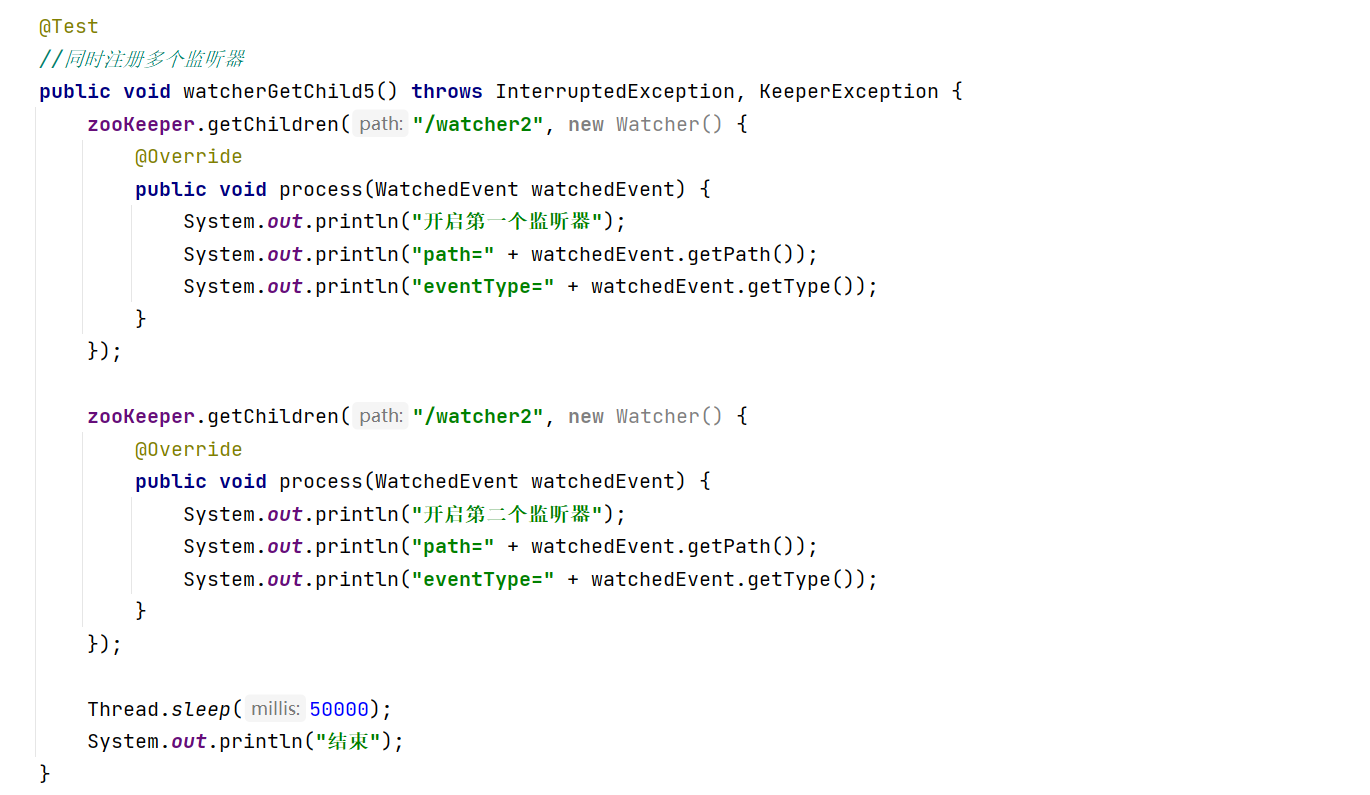























 被折叠的 条评论
为什么被折叠?
被折叠的 条评论
为什么被折叠?








